
 US Navy 50 Escort Aircraft Carriers (1942-44): USS Casablanca, Liscombe Bay, Coral Sea, Corregidor, Mission Bay, Guadalcanal, Manila Bay, Natoma Bay, St. Lo, Tripoli, Wake Island, White Plains, Solomons, Kalinin Bay, Kassan Bay, Fanshaw Bay, Kitkun Bay, Tulagi, Gambier Bay, Nehenta Bay, Hoggatt Bay, Kadashan Bay, Marcus Island, Savo Island, Ommaney Bay, Petrof Bay, Rudyard Bay, Saginaw Bay, Sargent Bay, Shamrock Bay, Shipley Bay, Sitkoh Bay, Steamer Bay, Cape Esperance, Takanis Bay, Thetis Bay, Makassar Strait, Wyndham Bay, Makin Island, Lunga Point, Bismarck Sea, Salamaua, Hollandia, Kwajalein, Admiralty Islands, Bougainville, Matanikau, Attu, Roi, Munda.
US Navy 50 Escort Aircraft Carriers (1942-44): USS Casablanca, Liscombe Bay, Coral Sea, Corregidor, Mission Bay, Guadalcanal, Manila Bay, Natoma Bay, St. Lo, Tripoli, Wake Island, White Plains, Solomons, Kalinin Bay, Kassan Bay, Fanshaw Bay, Kitkun Bay, Tulagi, Gambier Bay, Nehenta Bay, Hoggatt Bay, Kadashan Bay, Marcus Island, Savo Island, Ommaney Bay, Petrof Bay, Rudyard Bay, Saginaw Bay, Sargent Bay, Shamrock Bay, Shipley Bay, Sitkoh Bay, Steamer Bay, Cape Esperance, Takanis Bay, Thetis Bay, Makassar Strait, Wyndham Bay, Makin Island, Lunga Point, Bismarck Sea, Salamaua, Hollandia, Kwajalein, Admiralty Islands, Bougainville, Matanikau, Attu, Roi, Munda.WW2 US Carriers:
USS Langley | Lexington class | Akron class (airships) | USS Ranger | Yorktown class | USS Wasp | Long Island class CVEs | Bogue class CVE | Independence class CVLs | Essex class CVs | Sangamon class CVEs | Casablanca class CVEs | Commencement Bay class CVEs | Midway class CVAs | Saipan classThe world’s largest carrier program
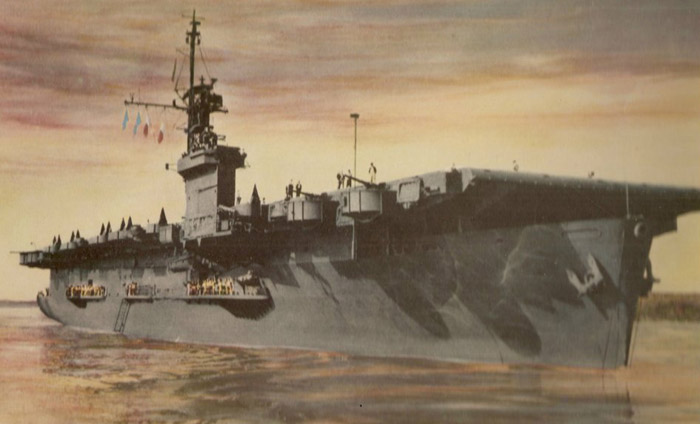
In late 1942, the USN urgently needed more aircraft carriers to face its obligations both in the Atlantic and Pacific. Conversion of existing C3 cargo hulls took time despite their seemingly easy and limited nature, and there was some desperation on how to increase the output.
In the early summer of 1942, Vancouver shipyard’s owner Henry J. Kaiser, already famous for the amazing output to deliver Liberty ships suggested the American government to manage the mass construction of a batch of 100 per year. His mass-construction simplification process and technology of continuous assembly and modular approach was, as he argued, adaptable to warships.
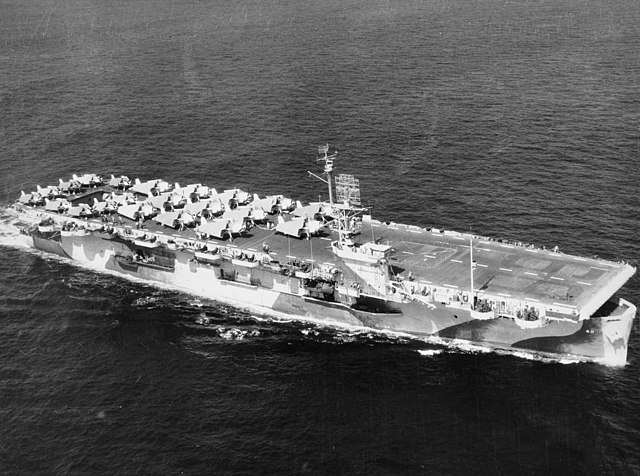
USS Guadalcanal(CVE-60) in 1944
President Roosevelt has become interested in the project, since in mid-1942, fleet carriers in construction were still far from ready and the need was urgent anyway. He confered with the yard’s team, Kaiser eventually being granted an offer to finance the construction of 50 aircraft carriers at once.
The Bogue class having been extensively tested successfully, it was proved that such vessels could provide air cover for the Pacific landing squadrons while continuing to serve in the Atlantic. Rather than scatter other series between several models of converted freighters, Henry J. Kaiser, the wealthiest holder of the largest and most prolific shipbuilding yards in Vancouver, Canada, proposed to the Admiralty to produce 100 escort carriers in record time (less than a year), based on his method of building Liberty Ships.
The Casablanca became the most prolific class of aircraft carriers in history. Although narrower and crampier than the Bogue class, their larger holds made it possible for them to carry more planes and fuel. They were also much faster thanks to their turbines, coming from fast cargo ships designed to escape U-Bootes. They were actually built in record time, the first, the USS Casablanca, laid down in November 1942 and into active service by July 1943 whereas the last one, the USS Shamrock Bay, was laid down in November 1943 and active in March 1944 (So in just in 5 months !).
They were ready in time for the great pacific operations, and 5 would be sunk in combat, USS Liscome Bay in November 1943, Gambier Bay and St Lô the same day during the battle of Leyte – victim of the Japanese guns. Kamikazes would also claim the USS Ommaney Bay in January and the USS Bismarck Sea in February 1945. After the war, some served for a time as ASW support and carriers thanks to their onboard helicopters. Most were broken up in 1960. They were a pure product of wartime and never intended to last long.
Genesis of the need, specifications and design
In WWI already, UK experimented in converting light cruisers to airplane carriers, as HMS Cavendish and depite the project was cancelled, it became subject of interest in the earlu interwar, more promising in some ways that the ponderous battleships conversiosn for fleet use. In 1925 already, the USN General Board considered the conversion of cruiser hulls to aircraft carriers. Treaty limitations still allowed for uncommitted construction tonnage to enable more carriers than authorized, using the treaty loophole of less than 10,000 tons ships. The IJN also took that alley, resulting in the Ryujo. About this uncommitted tonnage for small carriers, the board eventually reported:
“Incomplete studies of the subject by the Bureau of Construction and Repair and the meagre information available concerning the performance of airplanes from carriers of approximately 10,000 tons displacement does not justify building them at this time.”
“light” carriers resurfaced by May 1927 when LCdr. Bruce G.Leighton analyzed the problem in “Light Aircraft Carriers, A Study of their Possible Uses in So-Called ‘Cruiser Operations,’ Comparison with Light Cruisers as Fleet Units.” He already distinguished between CVL’s and CVE’s roles, between capital ships attack, fleet support and ASW patrols and reconnaissance. He considered them “worthy substitute for the light cruiser, or even preferable”.
In March 1939, Capt. John S. McCain, Sr. onboard USS Ranger (which experimented precisely the viability of such intermediate-light designs), wrote to the Secretary of the Navy about the ututility of eight “pocket-size” fast carriers (which Ranger was not) in orer to supplement fleet CVs rarther than replacing them.
Rear Admiral Ernest J. King answered his letter about a complete lack of enthusiasme for the idea and a diverisons of resources, suggesting instead that the Range was not the way forward due to her meagre air group and that the USN should pursue the largest air group reachable on the allocated tonnage instead (which was the goal with the Essex class). The Bureau of Construction and Repair however in 1940-41 as the war was on full swing, considered the feasability of converting fast passenger ships with short flight decks. By November 1940, the Chief of Naval Operations (CNO) confirmed SecNav when reporting the Chairman of the U.S.Maritime Commission that the characteristics of aircraft have changed in sauch a way no converted merchant vessel would be satisfactory as an aircraft carrier.
But some lowered ranks in the navy did not dropped the ball and “short-circuit” the hierarchy by directly calling President Franklin D. Roosevelt, a former naval officer, scretary of the navy, and always interested by it, actively enter the controversy. He pointed out that UK was now fighting a merciless war on the Atlantic against U-Boats and as many U.S.-built military aircraft arrived in leand-lease, as well as 50 destroyers, her urged the need for an escorting and aircraft-carrying ship for faster delivery rather than in the usual cargo crates. By mid-February 1941, Rear Admiral William F. Halsey wrote to CiC Adm. King:
“A previously stated expectation, that the Navy would be called upon to provide transport for Army aircraft, has now materialized in the current diversion of Enterprise and Lexington to transport 80 pursuit planes from the West Coast to Hawaii. To continue with primary reliance on aircraft carriers for such work, as is our present neces-sity, seriously endangers the availability of air-offensive power in the Fleet.”
Adm. Husband E. Kimmel endorsed it from his position as Commander, Aircraft Battle Force to the CNO. By October 21, 1940, the CNO received a memorandum from the President’s Naval Aide about testing the conversion of a merchant into an aircraft carrier. But it was bolder than just an aicraft taxi: It was to carry indeed 8 to 12 helicopters of the new Sikorsky type -not yet operational- or airplanes tailored for small decks and hangars. The idea of a quick conversion to spread an air cover ahead of convoys and detect U-Boats, dropping smoke bombs for the escorts to pick up.
The CNO on 30 December 1940 dediced to ask the chairman of the Maritime Commission to investigate this possibility. By 2 January they consulted their lists and found two refugee Danish ships offering such conversion capability. Later investigation however demented that prospect. The conference determined that the intended ships should be of standardized design for plans to be easily ported on mass-construction ships, and that the air group and types question should be further investigated.
They also estimated that defence should included four AA pom-poms and one 5-inches surface gun. But the converted merchant ship idea was definitely “in the tubes”. On January 6, 1941, Adm. Harold R. Stark, the current CNO, wanted a new conference in his Washington office to further discussed the matter. The autogiro type was soon eliminated (The IJN howewever will adopt it nevertheless) and that dropping smoke bombs only was a waste of time (as well as blimps). A better loaded aircraft with depht charges or bombs would be a better ASW proposal overall. The short deck idea was thus also dropped (This would not deter the Royal Navy to convert MACs (Merchant Aircraft Carriers)).
The meeting also concluded that diesel should bu used to eliminate smokestacks. The Maritime Commission was consulted for the conversion of C-3 cargo ships. They in response, answered that the Mormacmail and the Mormacland were suitable for conversion and available. This was reported to President Roosevelt and that a full conversion would last three months and acquisition was sanctioned on March 6, 1941. On June 2 was commissioned USS Long Island (AVG-1), and plans were made to convert the Mormacmail, but the Bureau of Aeronautics wanted a 350 feet deck to land its SOC SeaGulls. Long Island had a 362 feet deck, one elevator, a small hangar and 16 planes.
Mormacland was eventually sent to the RN as HMS Archer when completed by November 1941. Long Island essentually replaced USS Langley as a new test and training ship. It soon underlines the need of a broader deck and two elevators instead of one, as a longer flight, better AA and higher hangar. On December 26, 1941, the Secretary of the Navy approved the conversion of 24 merchant hulls as part of the 1942 shipbuilding program (The Bogue class). In March, her ordered the conversion of cruiser hulls (the ten CVLs or Independence class). However for large series, there were at the time only twenty C-3 hulls available for conversion and ten were already planned for the Royal Navy. Meanwhile USS Charger (CVE-30) tested more ideas andreplaced CVE-1 as training ship with closer caracteristics to the Bogues and subsequent CVEs.
The remaining four CVEs of the 1942 program were converted from Cimarron class fast fleet oilers (T3 class) later the Sangamon class, larger, with a larger flight deck of 503 feet by 85 feet, and enough hangar space to accomodate two small squadrons. They were rushed-completed for Operation Torch.
Meanwhile, the experience of the Atlantic convoy shed some light on possible CVE improvements, notably on carrier operations and tactics to adapt to the new U-Boats tactics, the placement of the catapult and elevators. Service experience with the Sangamon class brough some interresting returns. Reports were written on their daily used of TBF-1 Avengers, SBD-3 Dauntless and F4F-4 Wildcat in support of landing operations while in TF 34. Reports about their commitment in combat air patrol and anti-submarine patrols were noted.
All in all as commented the Atlantic Commander in Chief (CinCLant)
“The CVE’s proved to be a valuable addition to the Fleet. They can handle a potent air group and, while their speed is insufficient, thev can operate under most weather conditions and are very useful ships.”
. This report was not lost to Ernest King and revised his opinions.
This was balanced by Captain Calvin T. Durgin which reported:
“Due to their low speed, lack of protection and light armament, it is considered hazardous to employ a CVE group in operation where there is likely to be an effective enemy opposition.
Such a group can, however, be used to advantage, and is capable of inflicting substantial damage to the enemy in assault where the enemy air and sea opposition is negligible or when it is
being contained by other superior forces. When this situation exists, the CVE is well equipped to provide all support until landing strips are established ashore, and it can be effectively employed for bombardment spotting, combat air patrols over beaches and surface forces, for all forms of air reconnaissance missions and for bombing, rocket and strafing attacks.”
By the time the four Sangamons rejoined the Pacific at the end of 1942, the carried fleet was down to USS Enterprise and the Saratoga.
President Roosevelt before that announced new escort carriers would be built when visited by Shipbuilder Henry J. Kaiser. He impressed the President with his plan for mass production of escort carriers, a plan browing and under supervision by the Maritime Commission since early 1942.
Succession
USS Casablanca (CVE-55), the first of these, was commissioned July 8, 1943, leading a serie from CVE-55 to CVE-104. The order was complete by July 8, 1944, an impressive achievement. But the Sangamon class led to study a larger variant planned for the 1944 building program which became the first Navy-designed escort carriers for which hull and propeller model tests were carried out at the David W. Taylor Model Basin. The design was approved December 10, 1942 and the contract was let on January 23, 1943. The Commencement Bay (CVE-105) class was born. They measured 557 feet for a 19 knots speed, trial displacement of 23,100 tons. Most were commissioned just before V-J Day and incorporating all lessons learned since USS Long Island while the CVE type at large earned the respect of the Fleet by its service.
By December 13, 1944, the Escort Carrier Force, Pacific, was created and fell under command of RAdm. Durgin which evaluated the Sangamon class in North Africa. This was the result of the large number of escort carriers now available to the Fleet, thanks to the Casablanca class. Experience at Palau, Morotai and Leyte all pointed out better planning was necessary not to jeopardize their usefulness and unleash their full potential.
Scot MacDonald, based on reports by VADM. (THEN RADM.) Calvin T. Durgin, Commander, Escort Carrier Force, Pacific for NAVAL AVIATION NEWS, Dec. 1962. Src
About Henry J Kaiser
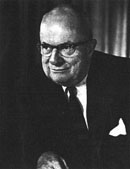 Henry John Kaiser (May 9, 1882 – August 24, 1967) was an American industrialist, “father of modern American shipbuilding”. He started in the construction industryand notably worked on the Hoover Dam. He formed Kaiser Aluminum and Kaiser Steel and later established the Kaiser Shipyards as a logical follow-up. Of course his most famous creation were the 2700+ Liberty ships of World War II, out-building what German U-Boats can sunk. After the war he turned to Kaiser Motors and the booming post-war automobile industry. He also diversified in the 1960s to other sectors.
Henry John Kaiser (May 9, 1882 – August 24, 1967) was an American industrialist, “father of modern American shipbuilding”. He started in the construction industryand notably worked on the Hoover Dam. He formed Kaiser Aluminum and Kaiser Steel and later established the Kaiser Shipyards as a logical follow-up. Of course his most famous creation were the 2700+ Liberty ships of World War II, out-building what German U-Boats can sunk. After the war he turned to Kaiser Motors and the booming post-war automobile industry. He also diversified in the 1960s to other sectors.
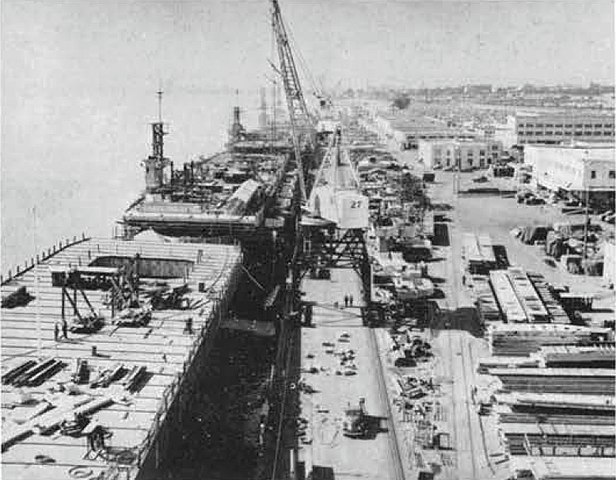
Escort carriers fitting out at Kaiser Shipyards circa April 1944
Of course it’s for his shipyards Henry J Kaiser was best known.
The Kaiser Shipyard in Richmond, California became the fastest and largest ship producer in the world, but it was not done on a single day: Henry J. Kaiser had been building cargo ships for the U.S. Maritime Commission already by the late 1930s. After September 1939, he started to receive additional orders from the British government and knowing his capability would be soon overrun by orders he established his first Richmond shipyard, in December 1940.
This soon accompanied by an innovative medical care (later “Kaiser Permanente”). The four Richmond Kaiser Shipyards built 747 ships in World War II which was an unsurpassed industrial effort for shipbuilding. His ships became the world’s cheapest built in 2/3 less time and at 1/4 cost. Robert E. Peary was became the recold holder of faster ship of that size ever assembled, in less than five days (it was a state-sponsored competition among shipyards). All in all by 1945 the yard built $1.8 billion worth of ships.
He achieved this feat by adapting production techniques specific to cargo ship construction with an emphasis on hyper-standardization and taylorization at any level, with an average construction time of 45 days. The Liberty ships were succeeded by the faster Victory ships. He changed his assembly techniques by visiting Ford, which convinced him to swap to welding instead of riveting. Not only it took less strength (and thus, was a job open to women) and was easier to teach, especially for unskilled laborers. Sub-assembliy and modularity was also key in the process.
The choice of Kaiser/Vancouver yard
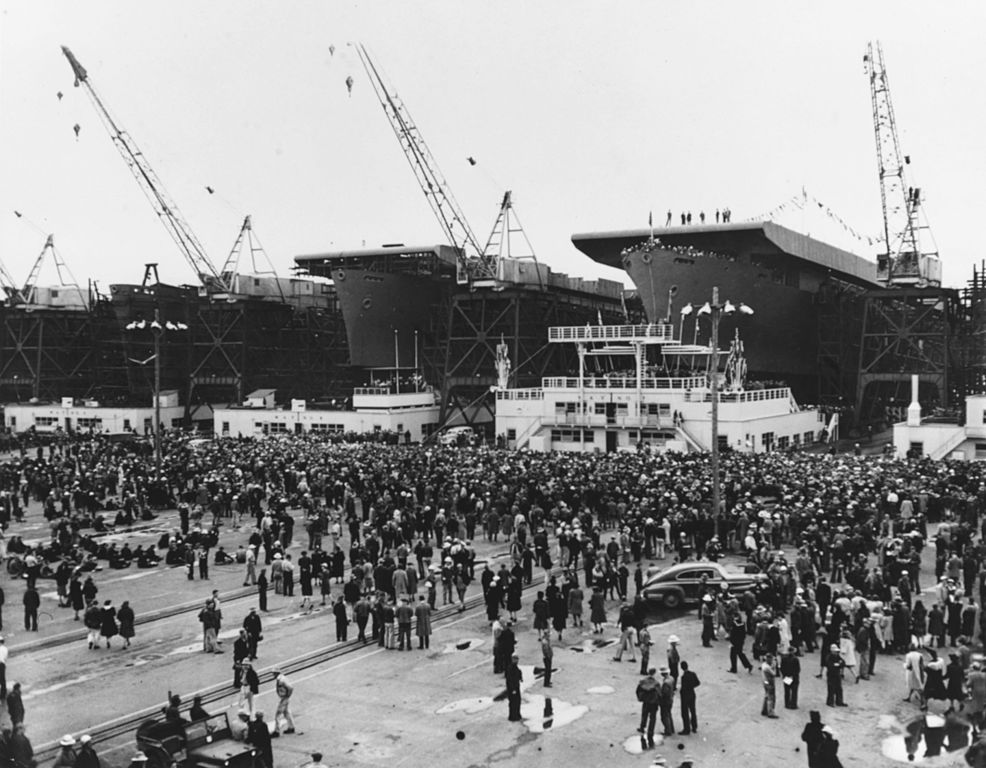
The success rate of the first led to the establishement of no less than three others shipyards, in Ryan Point (Vancouver), Columbia River (Washington state) and Swan Island (Portland, Oregon). He built also smaller vessels and one was turned in just 71 hours and 40 minutes at Vancouver yard on November 16, 1942.
Perhaps it’s no mystery that this was Kaiser/Vancouver which was chosen by Kaiser for his proposal to the president of a hundred Kaiser hulls converted as escort carriers, just reusing the techniques he mastered well, with assistance for the Navy for all the proper military fittings and installations. Although this was done in the completion phase.
The Vancouver Shipyard was an emergency shipyard, constructed along the Columbia River in Vancouver, Washington (not Canada !) for the U.S. Maritime Commission in 1942. The shipyard was located on the Pacific Northwest as the Oregon and Swan Island ones (both in Oregon). This yard started production in March 1942 over an area of 200 acres (81 ha) and five different types were delivered, but the most famous one by far were the Casablanca-class escort carriers, the yard’s largest “production line”. On Google Maps

Vanport, Oregon, nicknamed “Kaiserville” in 1943. This mushroom city was a feat of wartime public housing setup in Multnomah County.
This yard had a payroll of 38,000 workers which came mostly from Vanport, Oregon were considerable housing was raised to house the workforce in the area. In fact as it often happened in a yard built in such a “remote” location, a city practically emerged from the ground up, fed by additional personal and services dedicated to this workforce. The city was however almost destroyed by the 1948 Columbia River flood.
After the war, the Shipyard had no more orders (as the others in Oregon) and they were sold to Gilmore Steel for just $3.25 million.
At Kaiser Vancouver (now part of Portland subburbia), each new carrier was to be delivered as an “empty box” with a landing deck, catways, fittings for future sponsons, truncated exhausts, a wide and completely empty hangar and lift, and a small island with a lattice, also empty. The completion supervised by the Navy comprised all the electrical lighting and wiring, and basically everything above the main deck, so from the hangar floor.
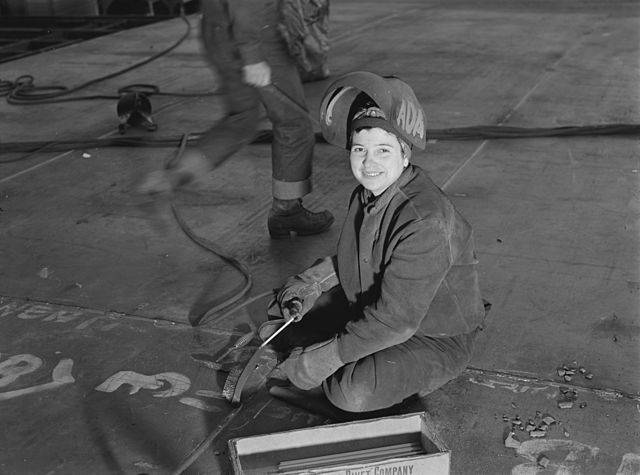
“Wendy Welder” at Richmond Shipyards. Feats of rapid construction were far less impressive for escort carriers due to the higher level of technicity.
One problem with welded hulls which surfaced after presidential approval for construction, and was more obvious after the war, was the issue of brittle fracture. This caused the loss of some Liberty ships in cold seas: Under both heavy load, bad weather and welding defects, welds failed, and hulls cracked, sometimes in two. Minor changes and more rigid welding control was only implemented from 1947, eliminated Liberty ship losses until 1955.
Kaiser also took part in the Joshua Hendy Iron Works of Sunnyvale in California building the standard EC-2 triple expansion steam engines used on all Liberty ships (the Victories had turbines). This led to the establishement of California Shipbuilding Corporation.
Anyway, welding did not affected the escort carrier life as apparently no significant accident was ever recorded and the losses by gunfire (St Lô) or Kamikaze attacks (xxx) were due to regular battle damage and fire rather than any structural issue. None broke in two as the result of severe impacts.
Construction Challenges
Term of building of the first 10 ships was 241-287 days, last ships of the class were built in 101-112 days or three months and a half on average. This was less stellar than Liberty Ships, but for warship construction of that scale and role, totally unheard of (and never surpassed). For comparison, a Yorktown class carrier took four years, an Essex-class two and a half. The same pre-fabrication and sub-assembly lines were used in a “leaf-pattern” to feed the central assembly line where the hull was assembled. This part was the fastest, and close to Liberty ships’s average delivery rates. It was the completion part which took most time.
As indicated above, the “empty box” delivered to the Navy needed to received many additional systems. Sensitive aviation fuel lines needed to be properly installed and checked, as well as the holds containing ammunitions (from bullets to depht-charges bombs and rockets), the intercom tested as well as communications lines to the AA gunners, machinery and central operation, and all the electronic equipments around the radars, displays, etc. They needed to be carefully calibrated. Crews were far larger than on Liberty ships (62 on average, counting the gunners and navy personal) versus on escort carriers: 910–916 officers and men total, including 50–56 for the air group, pilots and maintenance crews alike. This was more than ten times and implied far more accomodations, food and amenities to setup.
Vancouver Shipyards production setup
The hull chosen was the S4-S2-BB3 type according to the Maritime Commission Board registry. This was not even a wartime, but a prewar (for the US) project and registration. The U.S. Maritime Commission type S4-S2-BB3 emerged in 1941 as the Atlantic Convoys developed as the will to participated to the British desperate chase for aircraft carrier superiority. Planners estimated that military air cover was a crucial component of convoy escort and devise a type of small escort carrier based on the more civilian C4 type. The latter were 4th in rank and largest generic cargo type (hence the “C”).
The C4 were inspired by a designed originally for the American-Hawaiian Lines in 1941, and by late 1941, plans were taken over by the US Maritime Commission which designed a dedicated cargo/troopships in 3 shipyards: Kaiser Richmond, CA Yard No.3 Kaiser Vancouver, WA and Sun SB & DD in Chester PA. These were the largest cargo ships ever designed by MARCOM, with a single screw steam turbine and 9,900 shp, capable of 17 knots. The S4 was equipped ironically with a VTE which seems a step back, but sturdy enough to procured a top speed two knots above, at 19 kts.
Internally by the Commission the S4 were also described as “Kaiser-built Escort Carriers, Special Attack ships, Operation Crossroads”.
According to Kaiser-Vancouver logs here is the detail:
Legend: Hull# | Original Name | Type | MC# | Delivery Date | Pennant and final name:
301 | HMS Ameer | S4-S2-BB3 | 1092 | Jul-43 | CVE 55, renamed Alazon Bay, later Casablanca, scrapped 1947
302 | Liscombe Bay | S4-S2-BB3 | 1093 | Aug-43 | CVE 56, torpedoed and lost in the Pacific 1943
303 | Alikula Bay | S4-S2-BB3 | 1094 | Aug-43 | CVE 57, renamed Coral Sea, then Anzio, scrapped 1960
304 | HMS Atheling | S4-S2-BB3 | 1095 | Aug-43 | CVE 58, renamed Anguilla Bay, later Corregidor, scrapped 1960
305 | HMS Atheling | S4-S2-BB3 | 1096 | Sep-43 | CVE 59, renamed Mission Bay, scrapped 1960
306 | Astrolabe Bay | S4-S2-BB3 | 1097 | Sep-43 | CVE 60, renamed Guadalcanal, scrapped 1960
307 | Bucareli Bay | S4-S2-BB3 | 1098 | Oct-43 | CVE 61, renamed Manila Bay, scrapped 1960
308 | HMS Begum | S4-S2-BB3 | 1099 | Oct-43 | CVE 62, renamed Natoma Bay, scrapped 1960
309 | Chapin Bay | S4-S2-BB3 | 1100 | Oct-43 | CVE 63, renamed Midway, later St. Lo, kamikazied and lost at Leyte Gulf 1944
310 | Didrickson Bay | S4-S2-BB3 | 1101 | Oct-43 | CVE 64, renamed Tripoli, scrapped 1960
311 | Dolomi Bay | S4-S2-BB3 | 1102 | Nov-43 | CVE 65, renamed Wake Island, kamikazied off Okinawa 1945, scrapped 1947
312 | Elbour Bay | S4-S2-BB3 | 1103 | Nov-43 | CVE 66, renamed White Plains, scrapped 1959
313 | HMS Emperor | S4-S2-BB3 | 1104 | Nov-43 | CVE 67, renamed Nassuk Bay, later Solomons, scrapped 1947
314 | Kalinin Bay | S4-S2-BB3 | 1105 | Nov-43 | CVE 68, damaged at Leyte Gulf 1944, scrapped 1947
315 | Kassan Bay | S4-S2-BB3 | 1106 | Dec-43 | CVE 69, scrapped 1960
316 | Fanshaw Bay | S4-S2-BB3 | 1107 | Dec-43 | CVE 70, damaged at Leyte Gulf 1944, scrapped 1959
317 | Kitkun Bay | S4-S2-BB3 | 1108 | Dec-43 | CVE 71, damaged off Mindoro 1945, scrapped 1947
318 | Fortaleza Bay | S4-S2-BB3 | 1109 | Dec-43 | CVE 72, renamed Tulagi, scrapped 1947
319 | Gambier Bay | S4-S2-BB3 | 1110 | Dec-43 | CVE 73, sunk by gunfire at Leyte Gulf 1944
320 | HMS Kedive | S4-S2-BB3 | 1111 | Jan-44 | CVE 74, renamed Nehetna Bay, scrapped 1960
321 | Hoggatt Bay | S4-S2-BB3 | 1112 | Jan-44 | CVE 75, scrapped 1960
322 | Kadashan Bay | S4-S2-BB3 | 1113 | Jan-44 | CVE 76, scrapped 1960
323 | Kanalku Bay | S4-S2-BB3 | 1114 | Jan-44 | CVE 77, renamed Marcus Island, scrapped 1960
324 | Kaita Bay | S4-S2-BB3 | 1115 | Feb-44 | CVE 78, renamed Savo Island, scrapped 1960
325 | Ommaney Bay | S4-S2-BB3 | 1116 | Feb-44 | CVE 79, kamikazied and scuttled off Mindoro 1945
326 | Petrof Bay | S4-S2-BB3 | 1117 | Feb-44 | CVE 80, scrapped 1959
327 | Rudyard Bay | S4-S2-BB3 | 1118 | Feb-44 | CVE 81, scrapped 1960
328 | Saginaw Bay | S4-S2-BB3 | 1119 | Mar-44 | CVE 82, scrapped 1960
329 | Sargent Bay | S4-S2-BB3 | 1120 | Mar-44 | CVE 83, scrapped 1959
330 | Shamrock Bay | S4-S2-BB3 | 1121 | Mar-44 | CVE 84, scrapped 1959
331 | Shipley Bay | S4-S2-BB3 | 1122 | Mar-44 | CVE 85, scrapped 1961
332 | Sitkoh Bay | S4-S2-BB3 | 1123 | Mar-44 | CVE 86, scrapped 1961
333 | Steamer Bay | S4-S2-BB3 | 1124 | Apr-44 | CVE 87, scrapped 1959
334 | Tananek Bay | S4-S2-BB3 | 1125 | Apr-44 | CVE 88, renamed Cape Esperance, scrapped 1961
335 | Takanis Bay | S4-S2-BB3 | 1126 | Apr-44 | CVE 89, scrapped 1960
336 | Thets Bay | S4-S2-BB3 | 1127 | Apr-44 | CVE 90, later LPH 6, scrapped 1967
337 | Ulitaka Bay | S4-S2-BB3 | 1128 | Apr-44 | CVE 91, renamed Makassar Strait, to be sunk as target 1959 but grounded and broke up
338 | Wyndham Bay | S4-S2-BB3 | 1129 | May-44 | CVE 92, scrapped 1961
339 | Woodcliff Bay | S4-S2-BB3 | 1130 | May-44 | CVE 93, renamed Makin Island, scrapped 1947
340 | Alazon Bay | S4-S2-BB3 | 1131 | May-44 | CVE 94, renamed Lunga Point, scrapped 1960
341 | Alikula Bay | S4-S2-BB3 | 1132 | May-44 | CVE 95, renamed Bismarck Sea, kamikazied and lost off Iwo Jima 1945
342 | Anguilla Bay | S4-S2-BB3 | 1133 | May-44 | CVE 96, renamed Salamaua, damaged in Lingayen Gulf 1945, scrapped 1947
343 | Astrolabe Bay | S4-S2-BB3 | 1134 | Jun-44 | CVE 97, renamed Hollandia, scrapped 1960
344 | Bucareli Bay | S4-S2-BB3 | 1135 | Jun-44 | CVE 98, renamed Kwajalein, scrapped 1960
345 | Chapin Bay | S4-S2-BB3 | 1136 | Jun-44 | CVE 99, renamed Admiralty Islands, scrapped 1947
346 | Didrockson Bay | S4-S2-BB3 | 1137 | Jun-44 | CVE 100, renamed Bougainville, scrapped 1960
347 | Dolomi Bay | S4-S2-BB3 | 1138 | Jun-44 | CVE 101, renamed Matanikau, scrapped 1960
348 | Elbour Bay | S4-S2-BB3 | 1139 | Jun-44 | CVE 102, renamed Attu, sold for scrap 1947 but resold as Gay, scrapped 1949
349 | Alava Bay | S4-S2-BB3 | 1140 | Jul-44 | CVE 103, renamed Roi, , scrapped 1947
350 | Tonowek Bay | S4-S2-BB3 | 1141 | Jul-44 | CVE 104, renamed Munda, scrapped 1960
Impact of the Casablanca class on the war
It cannot be overstated as much WW2 involved an industrial colossal effort, several times greater than WWI, the first large scale industrial global war, and unlike any conflict of the past. At least the cold war only asked an incremental, peacetime evolution were output was gradually overshadowed by quality. In WW2, this was a Darwinian prospect. By December 1941, the “free world” seemed defeated on all fronts. Tanks and planes were produced by tens of thousands to be thrown into the furnace, but also ships – not small boats, but very large ones, demultiplying air power, seemingly the great winner of WW2.
Fifty aicraft carriers was an unprecedented number for that kind of vessel, never surpassed so far. It can be argued that they were so fast-buult, so simplified and low-cost they became “consumable” carriers a bit like the Liberty ships from the same yards, built with the same techniques, and as promised, a batch of 50 joined the 143 aircraft carriers built in the United States during the war. Perhaps the closest and only comparable endeavour today are the US Burke class destroyers, by cost and complexity several fold above the capabilities of the nimbler carriers.
By bolstering air power at low coast and quickly, these “Jeep carriers” spared the already hard-pressed Essex-class and Independence class making the bulk of the offensive fast carrier force of the Vth fleet in 1943-45. They provided indeed air cover for the numerous amphibious fleets deployed in the island-hopping campaign of the pacific, but also supply fleets, vital to keep TF38/58 operational on the long run, and the long supply chain which needed escort since Pearl Harbor to the far outreach of the Pacific, down to the US shores.
These 50 escort carriers were also split and part (a small one however) also took part in the vital role of escorting convoys in the Atlantic, since ASW warfare’s best answered soon appeared to be aviation, not least because U-Boats were more easily spotted from the air (and strafe them), but also to shoot down the Luftwaffe’s long range spotting planes such as the Fw200 Condor. The fifty carriers played this unglamorous but vital part of operations until construction stopped in July 1944. After the war, there fortune were diverse, many were stricken outright, other as late as 1960-64, still used as specialized ships (like aviaton transport), and then joined the civilian market, converted as freighters.
Design of the Casablanca class
General construction
Casablanca in many respects reminded Bogue but had smaller displacement, two shafts and was faster. As a design basis the fast dry cargo carrier of S4-S2ВВ-3 type was used, but, unlike the predecessors, new carriers were built quite new, instead of earlier carriers converted from merchant hulls.
Powerplant
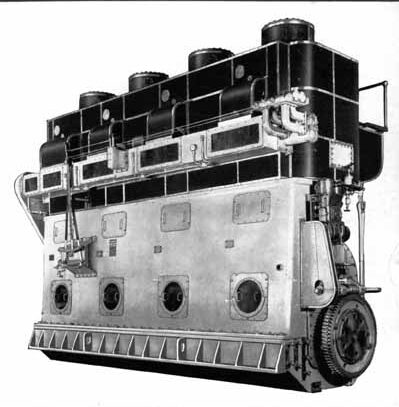
There were two propellers screws, on shafts driven by two Skinner Unaflow reciprocating, vertical quadruple expansion (9000 shp) steam engines. The final commercial evolution of the uniflow engine in the US was reached by the late 1930, up the early 1940s by the Skinner Engine Company from the Compound Unaflow Marine Steam Engine operating in a steeple compound configuration making it almost as efficient as a diesel. This was usual on car ferries on the Great Lakes and the Casablanca-class used two 5-cylinder Skinner Unaflow engines, but not steeple compounds.
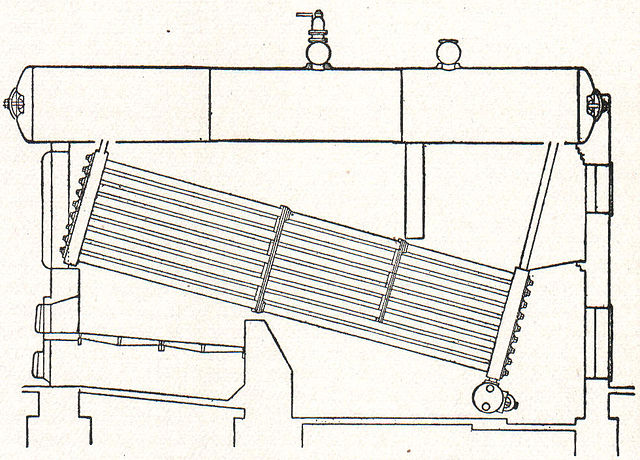
They were fed by four Babcock & Wilcox boilers. These were the common marine type, with a main balloon and series of small tubes below for expansion, double-ended.
Total output was 9,000 shp (6,700 kW). This allowed a top speed of 19 knots (35 km/h; 22 mph). There was a provision onboard of 2,228 tons fuel oil (in addition of the 120,000 gallons/454,000 liters aviation gasoline) for a Range of 10,240 nmi (18,960 km; 11,780 mi) at 15 knots (28 km/h; 17 mph).
The exhaust pipes were not truncated but rather ducted to the sides, two each side amidship and far apart to better vent smoke above the deck, at an ideal height for dispersion, as the wind blew stronger just over the deck surface, propelling the fumes outwards of the ship.
Armament
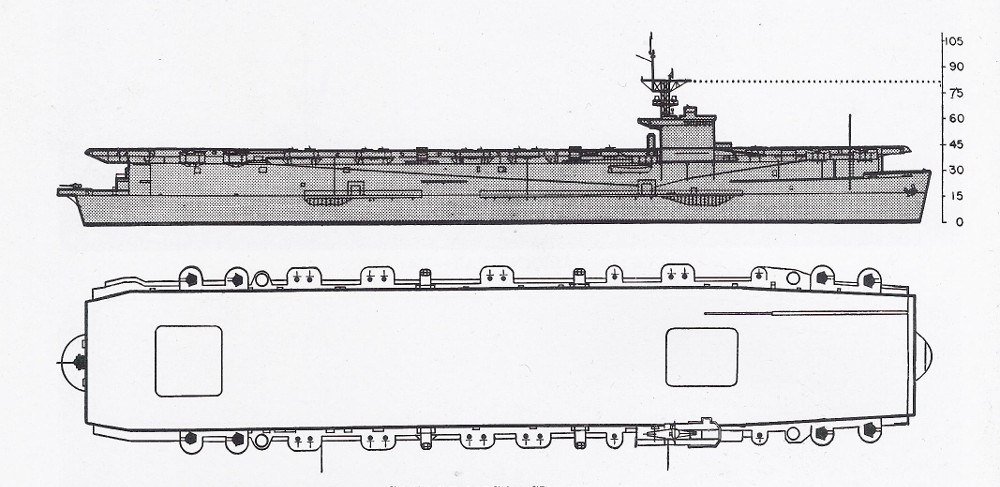
ONI Rendition of the ship – schematics.
It relied on the same usual “troika” of USN vessels of that era, with a single stern 5 in (127 mm)/38 cal dual-purpose gun, two quad 40 mm (1.57 in) Bofors anti-aircraft guns, and twelve 20 mm (0.79 in) Oerlikon anti-aircraft cannons around the flight deck’s sponsons.
Main: stern single 5-in/38
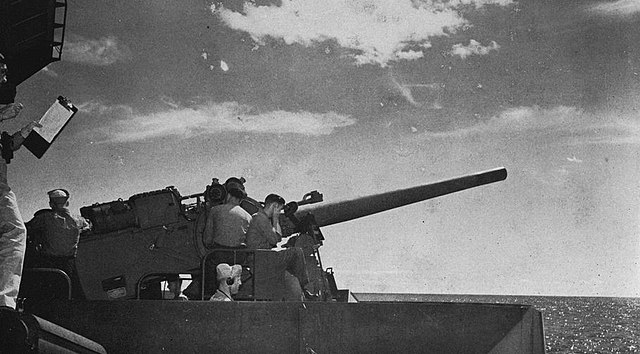
5-in/38 in action on USS Hollandia, 1945
This standard piece of ordnance shared by the whole US Navy and seen much as the best of its kind (a true dual purpose). The only issue of the Casablanca design was it’s location, a headache for engineers. It was placed on the poop deck and only could cover the rear 180° arc, with the landing deck partly above. The second issue was the lack of a protective shield against strafing or shrapnel in a naval engagement. More
40 mm Mounts
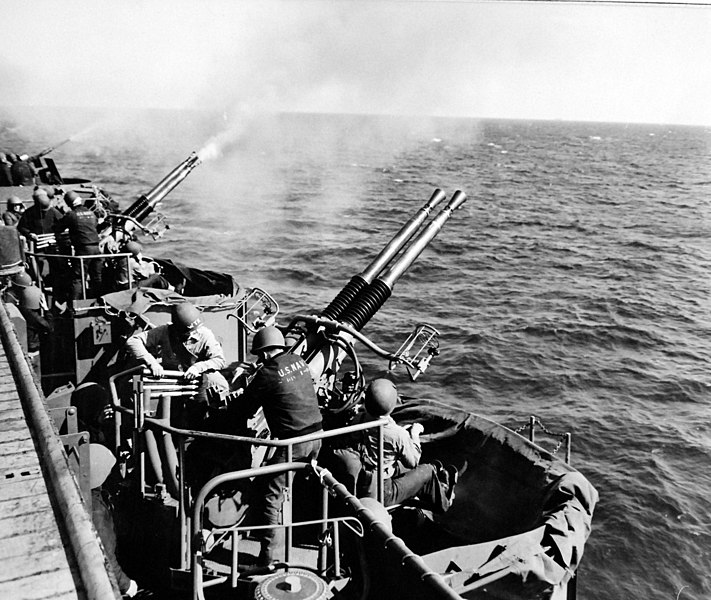
The twin mounts -there was no room for quad ones- were located fore and aft of the flight deck. These twin mounts were just in practice halved quad mounts. All parts were interchangeable. They had hydraulic-coupled drives to avoid salt contamination. These Mark IV twin mountings were derived from the Dutch Hazemeyer triaxial mounting from the minelayer Willem van der Zaan which took refuge in Britain in 1940. It was a self-contained mounting with its own rangefinder, radar and analog computer. There were two Mark IV water-cooled guns using track/pinion for elevation and training and a Ward-Leonard system for auto-tracking. It was somewhat delicate to use on small ships exposed to water spray, so more comfortable at the height of the carrier’s flight decks. It seems that crews preferred to use the manual mode over the power mode. It could elevate 25 degrees per second at 90°. The rest of the specs were the same as the common 40 mm/56 Mark 2.
More
20 mm Mounts
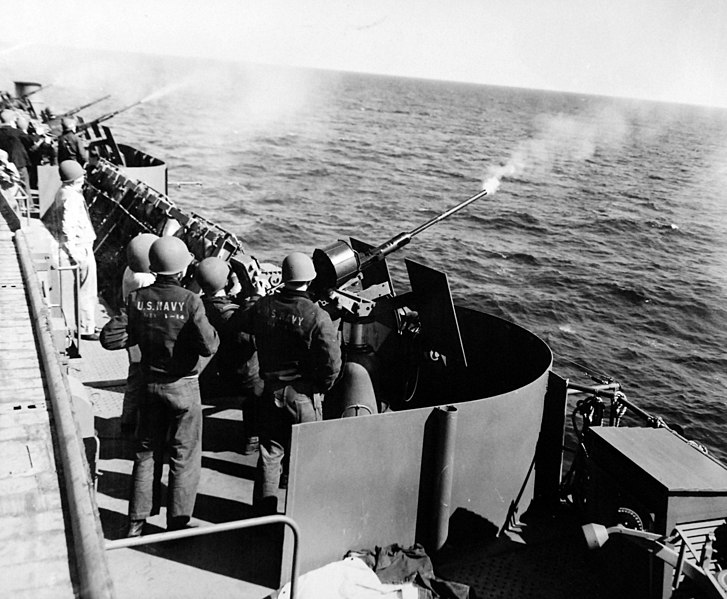
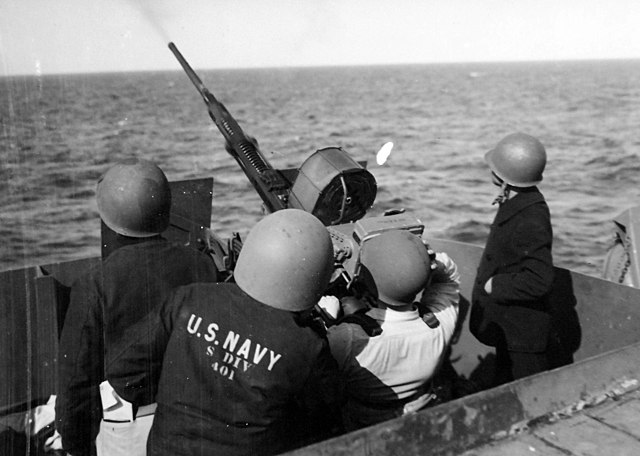
Standard L70 Oerikon piece, single mount, shielded, and placed along the deck’s side galley. This changed overtime, but the usual plan was two single sponsons forward of the bridge (one each side), behind the twin Bofors covering the angles, and two others behind or abadft the island, then twin mount sponsons all along the deck aft. The usual figure was four of these either side, so eight for sixteen single mount, and four single sponson mounts. This was increased during the war, making more room for extra single or twin sponsons. There were also four directoros for the AA artillery located on either end of the ship, close to the Bofors mounts. More.
SC and SG Radars and other electronic equipments
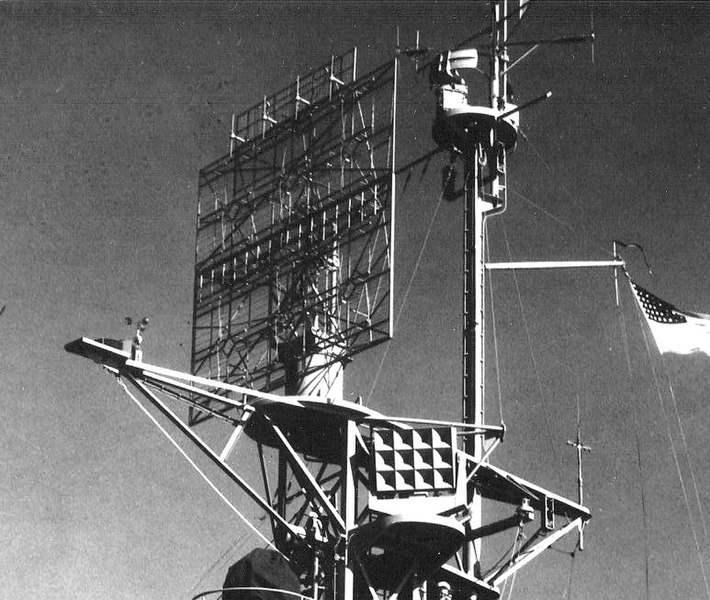
The SC air search radar was standard on most small to medium ships of the USN. It was completed by an SG surface search radar.
The 100 Kw SC CXAM-type radar had a Pulse Width of 5 microsecond, 60 Hz frequency, 5rp scan rate and detection of a bomber 30 nm (60 km) away, of a battleship at 10 nautical miles (20 km), a destroyer at 3 nautical miles (6 km), which was the bare minimum, greatly improved with the SC-1.
The SG was also 1st-gen model, small cut parabola at the front of the lower platform of the derrick. It was a 50 Kw model with the pulse Repetition Frequency of 775, 800 or 825 Hz, 4/8/12 rpm frequency, and 15 nautical miles (30 km) aerial range 22/15 nautical miles (30 km) for a surface ship from a battleship to a destroyer.
Both were located on the derrick mast over the bridge.
Some units had their radar upgraded to SC-2 or SK (respectively) later in the war (1945).
Aircraft facilities

They were fitted with two inboard elevators and a single steam catapult installed at the forward end of the flight dekc, to the right (port) unlike the Essex class which had it to the right, but in conformity to earlier designs. There was a single hangar with safety sprinklers and a damage control CP. Like other designs of the time, the avgas tanks were buried deep into the hull. The elevators had not the same size, the aft one was larger to accomodate planes without wings folded. Both rectalngular with rounded edges, the forwards one was in the axis, turned the aft one across. In total they carried 27 planes less spares, although the limited hangar space could not allow much to be suspended under the roof.
Air group
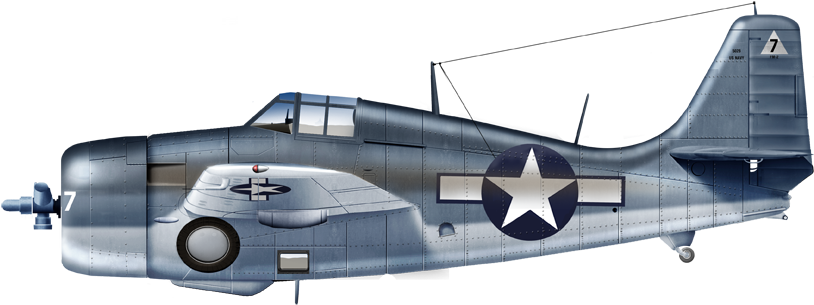
East Aircraft FM-2, VC-2, USS White Plains 1944
Globally, this air group was more diverse was usually assumed. It was composed of the F4F GM Wildcat as main fighter, but in some cases the F4U Corsair was operated as the F6F Hellcat. The SBD Dauntless dive bomber (SBD-5) was more common as the TBF Avenger. For reconnaissance some had one or two Curtiss SOC Seagull, F4F-P Wildcat but more rarely the F4U-P Corsair and F6F-P Hellcat.
The air group varied in time and role: For thos kept for convoy escort in 1943, notably in the Atlantic, the ypical air group comprised nine F4F-8/FM-2 and ten up to 12 TBF-1/TBM-3 Avenger.
By August 1944, USS Kasaan Bay had aboard 24 F6F-5 and 7 F6F-3N, so a very specialized batch of Hellcats, including a heavy reconnaissance component. This was 31, presumably many were a “permament park” on deck.
By April 1945 USS Fanshaw Bay typically had the “standard” air group comprising twenty-four F4F-8/FM-2 for air defence and six TBM-3 for any surface/ASW threat, showing air defence was paramount, notably to protect the assault fleet against Kamikaze attacks.
USS Savo Island at the same time however had twenty F4F-8/FM-2 and 11 TBM-1C plus four TBM-3, mostly used for attacks, notably over Japan. The latter were gradually equipped with rockets, but consumed bombs as standard.
Fighters: General Motors FM-1/2 Wildcat
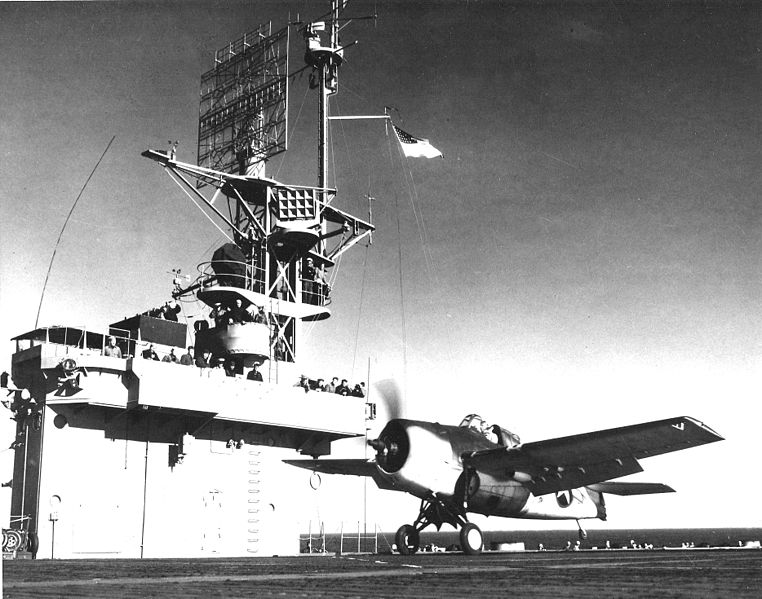
FM-1 Wildcat takes off from USS Kassan Bay in 1944
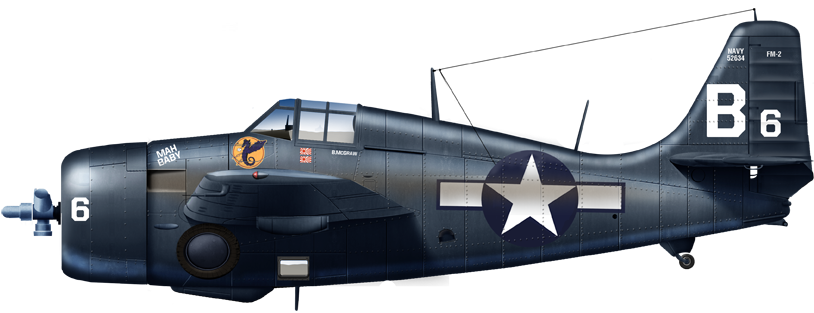
FM-2 VC-10 onboard USS Gambier Bay October 1944: She was sunk at the battle of Samar

Eastern Aircraft FM-2, “judy” VC-14 USS Hogatt Bay (CV-75), Emirau Island (Bismarck Archipelago), May 1944.
Fighters: Grumman F6F Wildcat
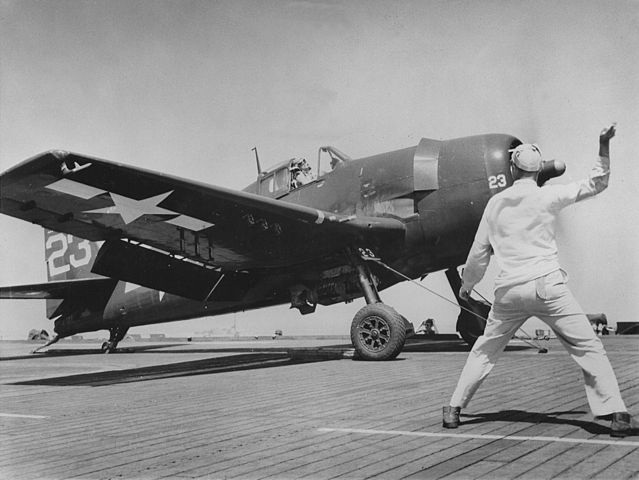
F6F-5 taking off from USS Kasaan Bay off France, June 1944. The F6F was far less common aboard due to her larger size, and only adopted notably in some cases and missions, like landing cover, owing a possible appearance or enemy planes. Since it was far more rare for CVs escorting convoys, the nimbler Wildcat was the norm.

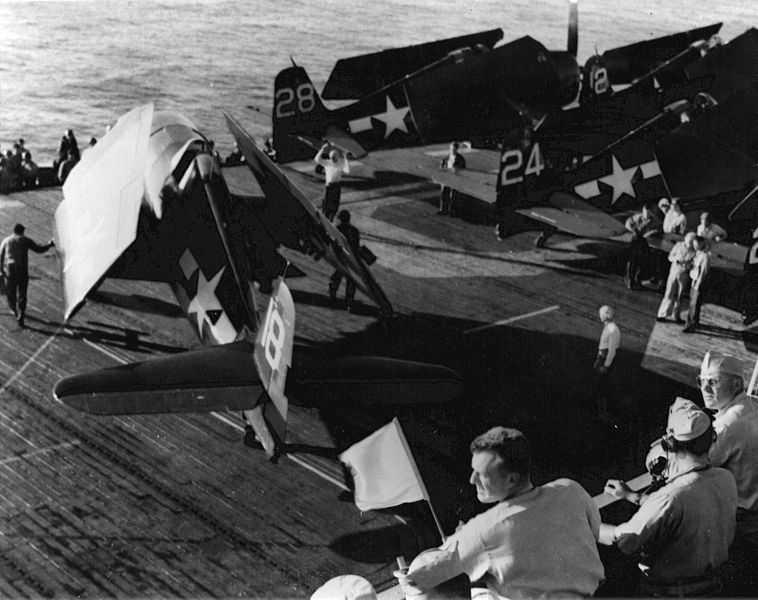
Same as above, F6F from VF-74 from VCE-69, France 1944
Fighters: Vought F8U Corsair
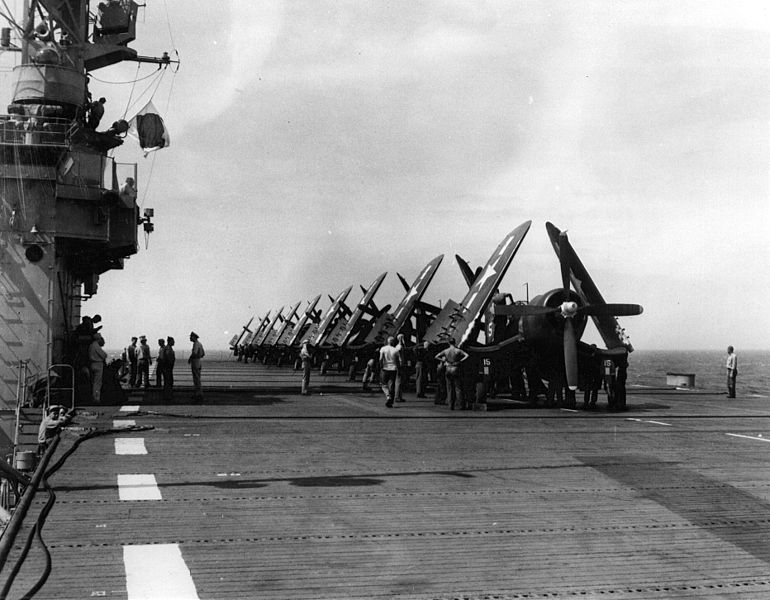
F4U-4 Corsairs of VB-3, USS Solomons, making their qualifications in july 1945
Torpedo-Bombers: Grumman/GM TBM Avenger
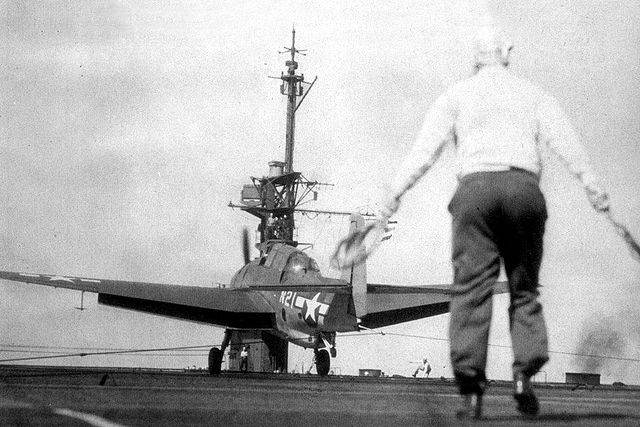
Grumman TBF landing on USS Marcus Island, 5 March 1944. This was a first. This “juggernaut” became common as standard torpedo bomber, but in around 1/3 of the entire air group, completed by Wildcats most of the time. It was preferred over the Helldiver, but its large weight meant for taking off, it needed the whole deck lenght, and landing was always a more perilous exercize compared to roomy fleet carriers.


Douglas SBDs and Grumman TBFs on an escort carrier in 1943
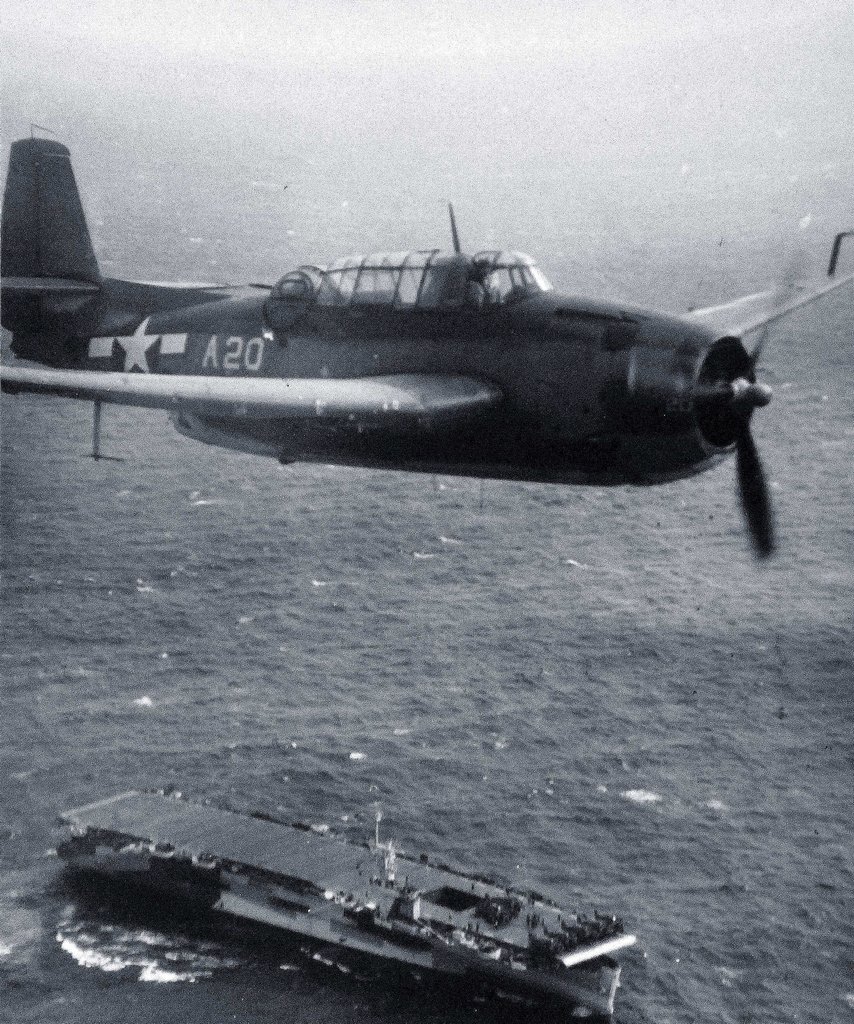
TBM flies above USS Saginaw Bay, 14 June 1944
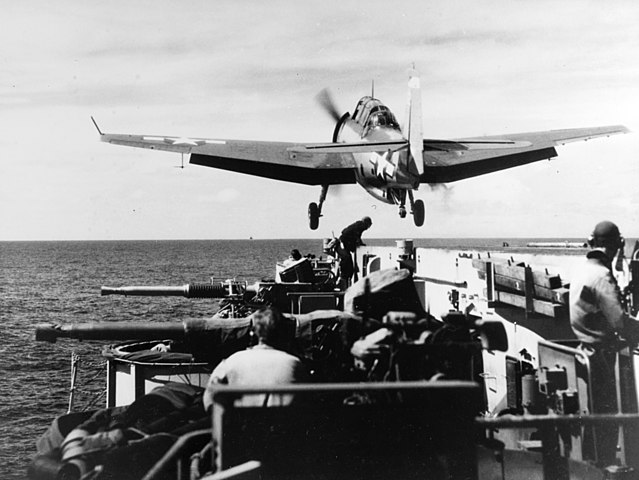
Dive-Bombers: Curtiss SB2C Helldiver
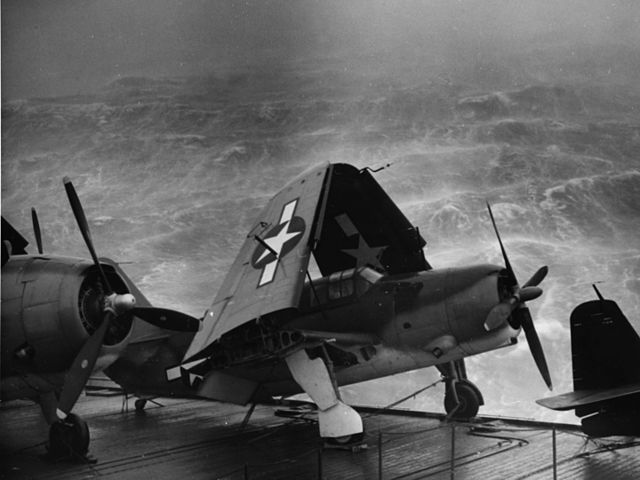
An SB2C on USS Kwajalein during a Typhoon in late 1944. The Helldiver was not liked much and if part in some occasions of CVE’s air groups, it was reserved for special operations and in particular in amphibious landing cover, both to deal with any ground objectives, but also with an always possible enemy fleet attack, as shown during the battle of Samar (Taffy 3 defence).
Unfortunately i can’t find a profile of one.
Reconnaissance: Curtiss SOC Seagull
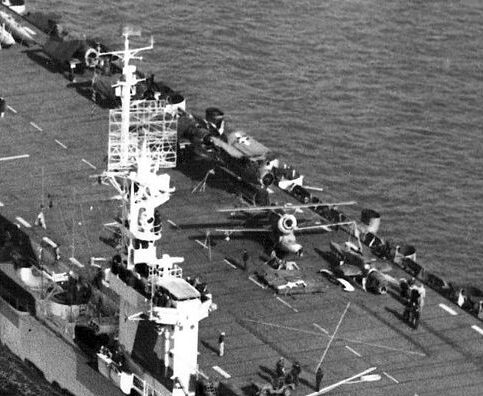
The U.S. Navy escort carrier USS Savo Island (CVE-78) underway in May 1944, location unknown. Note dismantled SO3C Seamew, a J2F Duck (minus its engine), and SOC Seagull and three F6F Hellcats lining the port side, with spare floats lashed down aft.
Tactics and combat actions
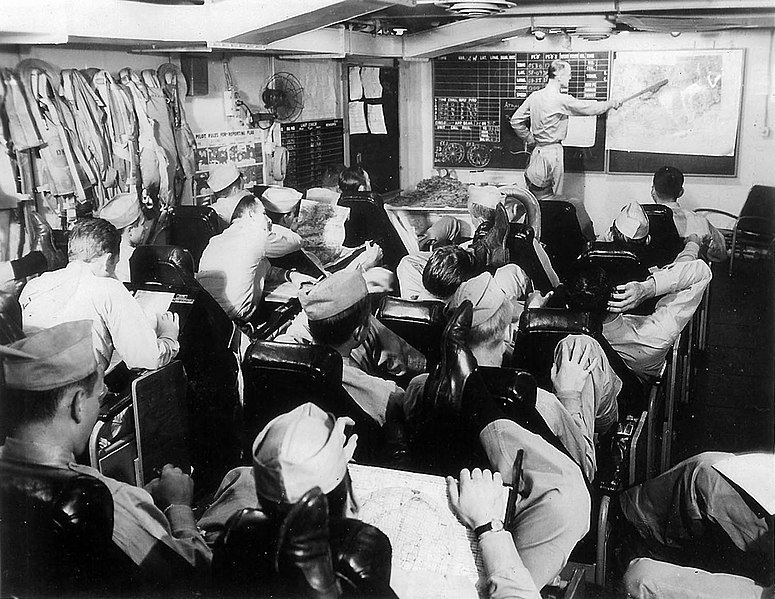
Pilot Briefing aboard USS Kasaan Bay in 1944.
When the first of these ships were commissioned in the summer of 1943, the face of the war in the Pacific already had drastically changed, as the USN was no longer “hanging by the nails” with a few interwar careers and cruisers to stand up to the IJN. The first two Essex class fleet carriers just arrived and relieved this fatigued force centered around the battered USS Enterprise and Saratoga, as well as the first seven CVLs (Independence class) that brought a breath of fresh air to the US Forces, enabling to consider a steady counter-offensive.
A hard to fit new type
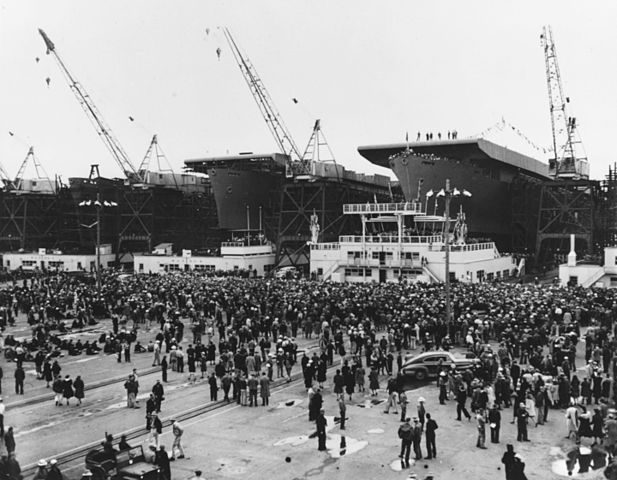
USS Casablanca (ACV-55) about to be launched on 5 April 1943
Tactically, discussion in the admiralty board, submitted with this unexpected mass-built design, had little doubts about its use. Too slow to take part in main combat operation with the fleet (That was the role attributed to the core of TF38/58) they were relegated to two other forces: The assault fleet, mostly comprising troopships and their escort, and the slower auxiliary fleet, supply and depot vessels, repair ships and oilers. Both were to be protected by the fast carrier fleet, taking a more active role allowed by its speed.
The bulk of the assault and auxiliary fleet was made of civilian-grade ships capable of 15 knots on average. Thus the 19 knots of the Casablanca were perfectly adequate. The seocnd point was about their air group. It was not large enough for the air naval doctrine at the time. The “100-planes assault” or “sunday punch” was the new norm for fleet carriers, enabling a better coordination. The CVLs were mostly there to provide a CAP and resupplying losses. But the small groups of the CVEs limited them to air defence, which was shown in the majority of their composition, which was mission-dependent. They usually had a full fighter squadron, but a half-squadron for attack.
For those potentially deployed in the Atlantic, a perhaps more balanced air group as envisioned, with the TBF Avenger used as main ASW patrol/strike plane. The Luftwaffe was not really a threat by late 1943 over this theater. But for the sake of standardization the Casablancas were kept for the Pacific, which was not the case for the Bogue class.
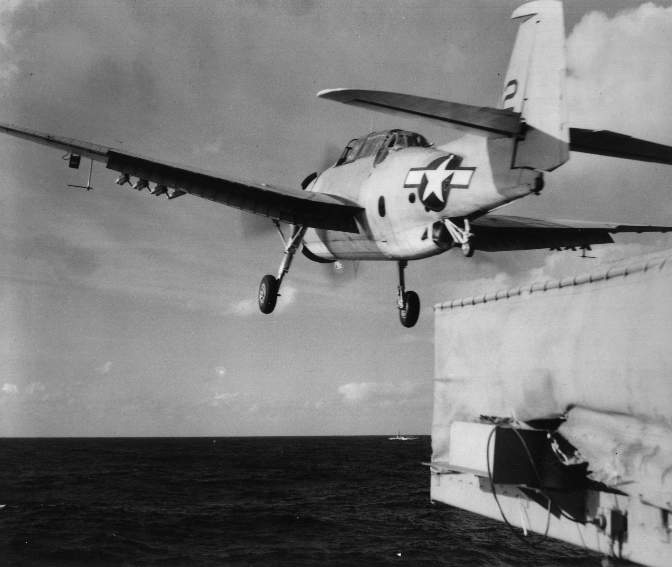
USS Guadalcanal in the Battle of the Atlantic: Its TBMs about to be launched for an attack on U-544. The combination 5-in rockets/depth charges was found the best in early 1944.
Thus, a distinction was made for those assigned to assault forces: Their air group in proportion comprised a more balanced ratio of attack planes versus fighters in order to participate to the air support during the assault. Something that partly freed the fast carrier force for more important objectives, preventing reinforcements and distant strike assets (like airfields on other islands) for example or diversionary actions. In short the CVEs provided the “close air support” for the invasion force, both a permament CAP in case of Japanese aircraft from other airfields/bases not neutralized by the fast carrier force (which happened often, with unexpected Kamikaze attacks), and direct and on-demand air support.
A place found and secured
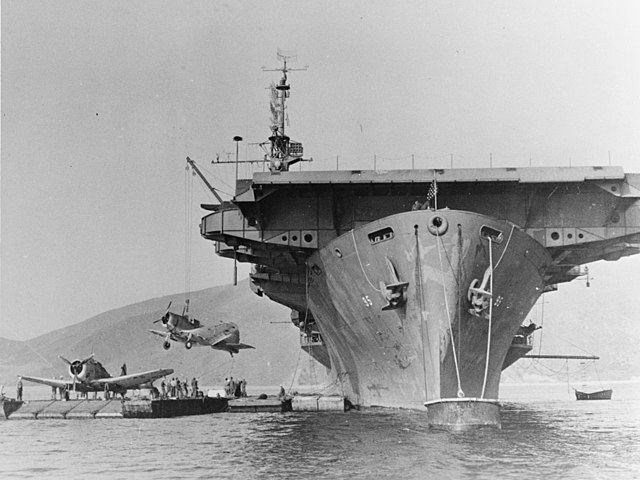
USS Bismarck Sea CVE-95 loading Douglas SBD Dauntless bombers from a barge circa in 1944.
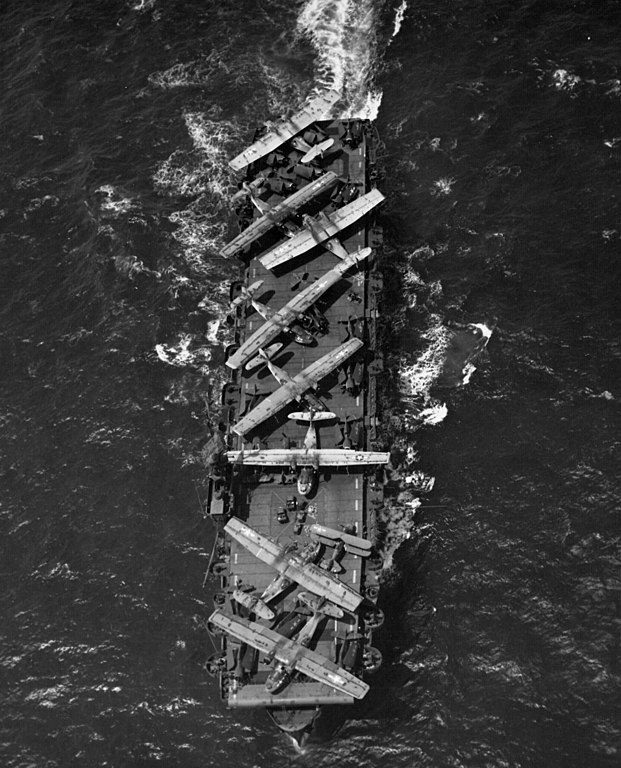
The initial role as planned early in 1941 by President Rooselevelt was a quick conversion of merchant vessels to taxi all sortts of aircraft delivered via lend-lease. They could simply be flown instead of delivered by crate, transported to an airfield, assembled and tested, which was the usual way in peacetime. The Casablanca class carried all sorts of aircraft types, including very large ones. Here USS Thetis Bay loaded with eight Catalinas and a dozen smaller types under their shadow.
When the first CVEs were starting their training, meanwhile in the Pacific the Invasion of New Georgia was near its completion (30 June-5 August 1943). This was the first major Allied offensive in the Solomon Islands after Guadalcanal, a closing point to the gruelling match that was ongoing since last August 1942 and seeing many battles. Also the operations they missed were the Gilberts invasion from 20 July 1943 at Tarawa and Abemama atolls, Nauru Island (Operation Galvanic).
It’s by the end of the year that most CVE were at last fully ready for combat, with their pilots qualified. The invasion of Makin Island in September (Marines landed from USS Nautilus) and the full invasion in November supported by the first CVEs, and among these, three Casablanca-class vessels, which air group was mostly intended for assault, with Douglas SBD Dauntless dive bombers and Grumman TBF Avengers. These were USS Liscome Bay, USS Coral Sea and USS Corregidor.
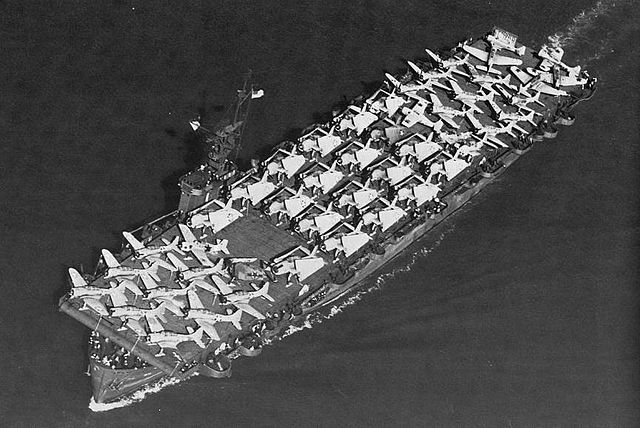
The former was the sole loss (and first of the class), spotted at dawn on 24 November by the Japanese submarine I-175, arriving unnoticed prior to the invasion and by a single torpedo hit off a full spread. The torpedo detonated just outside, blewing up its aerial bombs stockpile, trigerring a detonation that broke her in two, with 644 going down, including flagship admiral, TG commander Rear Admiral Henry M. Mullinnix and Captain Irving Wiltsie, plus Pearl Harbor Navy Cross recipient Cook Third Class Dorie Miller (with a new fleet carrier named after him). The latter investigation shown the destroyer screen composed of USS Hull and USS Franks were not in place when this happened and they were not zigzaging, to make support operations easier.
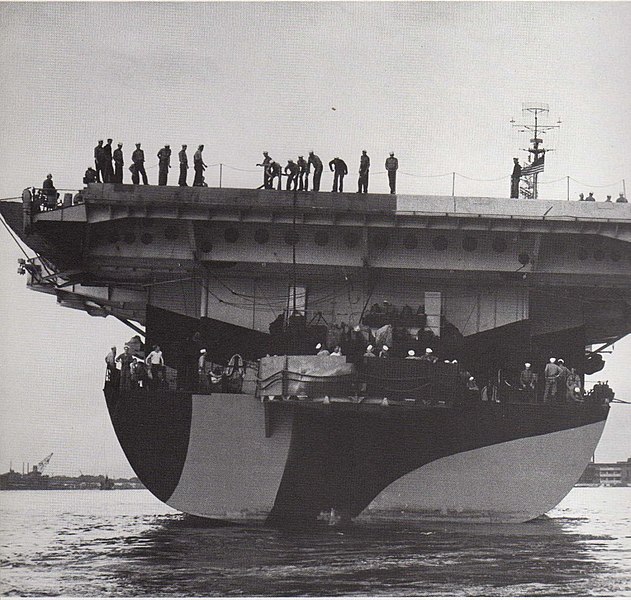
USS Anzio (CVE-57) at Pearl Harbor, 5 October 1944
On the 15th, escort carriers provided direct support for landings on Mindoro and the next two days. By January 3-22, 1945 some 17 escort carriers covered the approach of the Luzon Attack Force as part of Task Group 77.4. They made preliminary strikes in the assault area and covered the landings, supported the inland advance. RAdm. Sample with six carriers, provided air cover and support at San Antonio (near Subic Bay) and by February, Adm. Durgin directed his carriers at Iwo Jima.
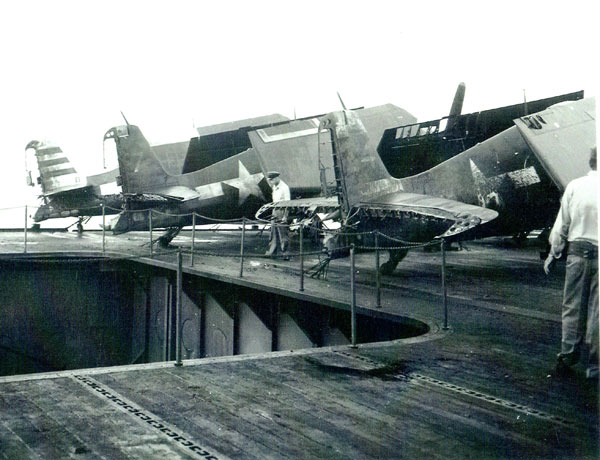
Damaged Hellcats F6F-5 aboard USS Admiralty Islands, 20 July 1944
In March he commited his reinforced carrier group at the Okinawa campaign at the head of Task Group 52.1 (18 escort carriers). Missions included pre-assault strikes, occupation support of Kerama Retto, pre-assault strikes on Okinawa, landings support, CAP and ASW patrols, daily close support.
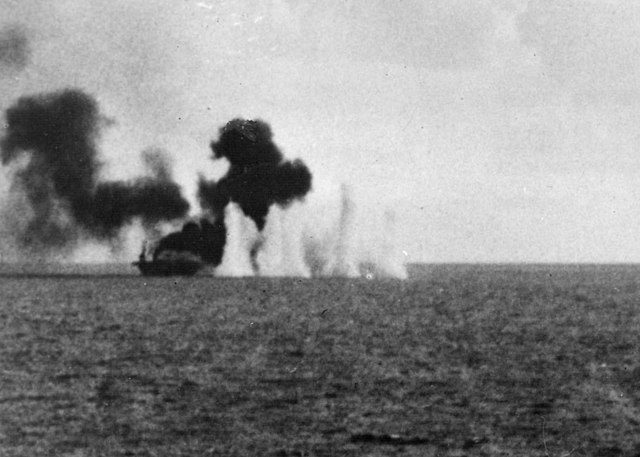
USS Gambier Bay under fore at Samar, 1944
Losses of CVEs were not heavy according to WW2 standards. Five were lost in the Pacific and one Bogue class in the Atlantic. The losses were due mostly to unexpected attacks: Naval surprise for St Lô at Leyte, she never was supposed to deal with heavy warship gunfire, Kamikazes that went through or submarines sneeking in, classic loss clauses that had few remedies but better patrolling from escorting destroyers and heavier combined AA, better CAP tactics, or just avoiding negligence in the face of clever tactics as shown by the Taffy-3 case.
Camouflage Liveries
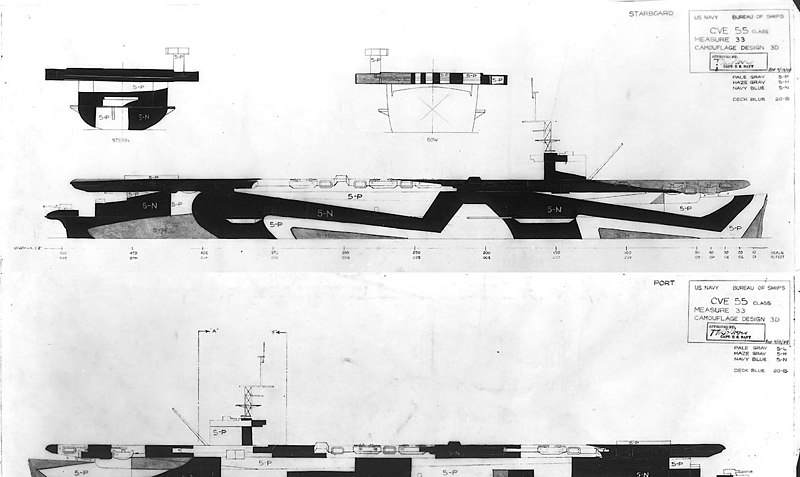
Camouflage Pattern MS-33 Design 3D for the Casablanca class.

Old author’s illustration of USS Casablanca in 1944. More recent ones ar coming, and a poster with the fifty carriers.

USS Gambier Bay as she was when sunk at the battle of Samar in Taffy 3, Leyte October 1944.
USS Casablanca (1942) specifications (to edit) |
|
| Displacement | 8,188 t. standard -10 902 t. Fully Loaded |
| Dimensions | 156.16 m long, 33 m wide, 6.32 m draft |
| Propulsion | 2 shaft Skinner Unaflow turbines, 4 Babcock & Wilcox boilers |
| Speed | 9,000 hp, 19 knots |
| Armament | 1 x 5 in (127mm), 8 x 40 AA (4×4), 12 x 20 mm, 27 aircraft |
| Armor | None |
| Crew | Circa 860 |
The Casablanca class coldwar career (1946-1964)
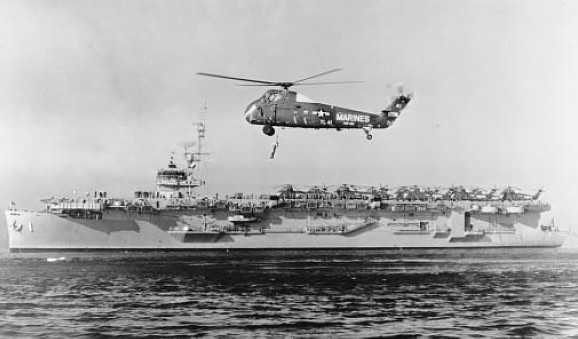
USS Thetis Bay (CVHE-1) 1950s
A bunch of these carriers stayed active for a few more years after their initial decommission in 1946-47, which was the fate of all there fifty ships. With the war of Korea however an inspection commission examined those in the best general state to be refurbished and recommissioned, at least as aircraft/helicopter carriers/taxis.
There were:
USS Corregidor: Reactivated 19 May 1951 decomm. again 4 September 1958
Cape Esperance: Reactivated 5 August 1950, decomm. 15 January 1959
Thetis Bay: Reactivated 20 July 1956, decomm. 1 March 1964
Windham Bay: Reactivated 28 October 1950, decomm. 15 January 1959
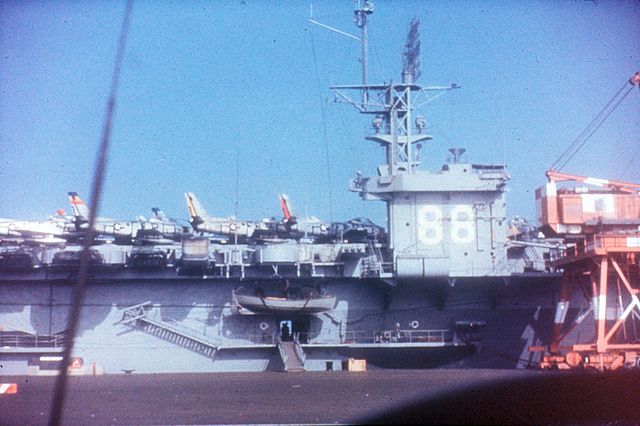
First F-86s arrive in Korea on USS Cape Esperance, Nov 1950
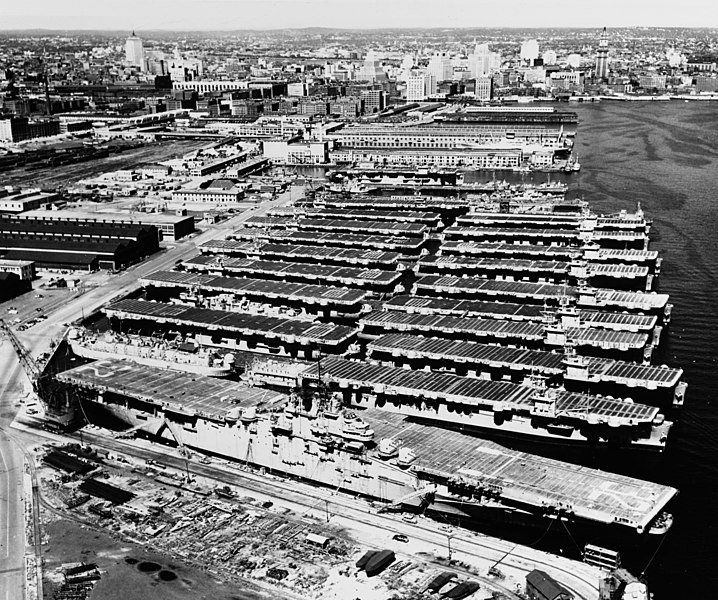
USS Leyte CVA-32 and Reserve Fleet escort carriers at the South Boston Naval Annex 25 July 1953
Many were still around in 1958, in long preservation, and were simply discarded and scrapped or expended as targets like Makassar Strait in 1961.
Note: They will be the object of a separate article in the cold war section.
USS Thetis Bay (CVE-90) had the longest career, as from September 1945 she joined the “Magic Carpet” fleet, and by August 1946, joined the Tacoma group, Pacific Reserve Fleet.
She was reactivated from May 1955, leaving the Pacific Reserve Fleet, towed to the San Francisco Naval Shipyard to be converted under project SCB 122, the first USN assault helicopter carrier. On 1 July, she became CVHA-1, in support of attack transports for vertical assault capabilitie, recommissioned on 20 July 1956 with the aft section of her flight deck cut away. She trained with the Marine Corps Test Unit No. 1 in Camp Pendleton and taking part in amphibious training exercises off of the California coast.
The evaluation complete, she departed for the Far East on 10 July 1957. She would returned there in 1958. In 1959 she became LPH-6 and was repaired after Typhoon Billie while in Taiwan. She put to good use her 21 Marine Corps Sikorsky H-34s to ferry aid and transporting civilians after a massive flooding. Back in the US she took part in the first large-scale night landing of ground forces by carrier-based helicopters. She was back in the Pacific’s 7th fleet in 1961, and in 1962-63 operated off the Atlantic coast and Caribbean. She took part in the Cuban Missile Crisis‘s naval “quarantine” having a marine landing team ready for action. In late 1963 she helped Port-au-Prince after a storm, providing medical aid and food supplies.
In January 1964 she was sent to the Naval Inactive Ship Maintenance Facility in Philadelphia for inactivation work, struck 1 March 1964, sold by December 1964, BU 1966.
Gallery

A model of USS Gambier Bay
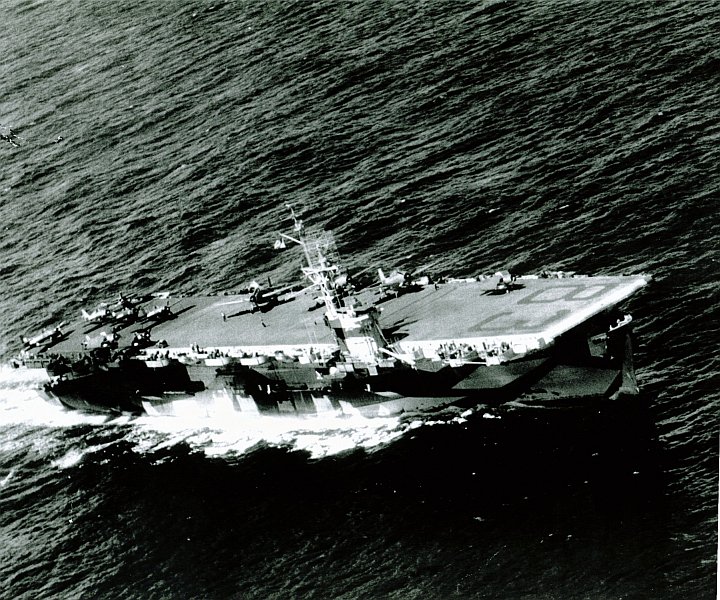
USS Sargent Bay CVE-83 underway 1944
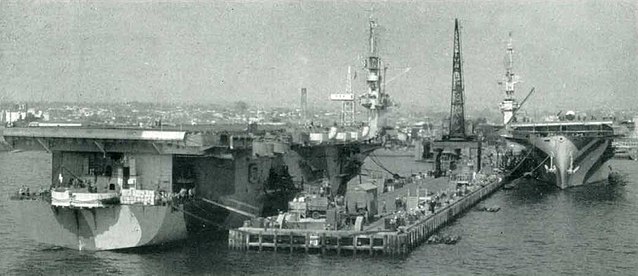
US Navy escort carriers at San Diego circa in June 1944

USS Admiralty Islands CVE-99 ferrying planes 31 December 1944
Resources
Links
https://commons.wikimedia.org/wiki/Category:Casablanca_class_aircraft_carriers
https://en.wikipedia.org/wiki/Casablanca-class_escort_carrier
https://www.navypedia.org/ships/usa/us_cv_casablanca.htm
http://www.usmm.org/c4ships.html
https://www.maritime.dot.gov/taxonomy/term/51?page=2
https://www.oregonencyclopedia.org/articles/kaiser_shipyards/#.XDUjKs9KjjA
https://www.columbian.com/news/2013/aug/19/war-effort-clark-county-kaiser-shipyard/
http://shipbuildinghistory.com/shipyards/emergencylarge/kvancouver.htm
https://www.ibiblio.org/hyperwar/USN/ships/ships-mc.html#s4
http://www.hazegray.org/navhist/carriers/us_esc2.htm
https://www.navsource.org/archives/03/055.htm
https://www.navsource.org/archives/03/055co.htm
https://www.history.navy.mil/research/histories/ship-histories/danfs/c/casablanca.html
https://www.history.navy.mil/content/dam/nhhc/research/histories/naval-aviation/evolution-of-aircraft-carriers/car-9.pdf
https://www.history.navy.mil/content/history/museums/nmusn/explore/photography/ships-us/ships-usn-l/uss-lunga-point-cve-94.html
http://www.navsource.org/archives/03/063.htm
http://www.navsource.org/archives/03idx.htm
https://www.navysite.de/cve/cve55class.htm
https://uboat.net/allies/warships/class/110.html
https://tmg110.tripod.com/usn_cve.htm
http://pwencycl.kgbudge.com/C/a/Casablanca_class.htm
https://ww2db.com/ship_spec.php?ship_id=297
https://www.globalsecurity.org/military/systems/ship/cve-55.htm
https://nationalinterest.org/blog/reboot/how-casablancas-class-aircraft-carriers-shook-world-war-ii-188673
https://commons.wikimedia.org/wiki/Category:Casablanca_class_aircraft_carriers
Books
John Gardiner Conway’s all the words fighting ships 1921-47
The Escort Carrier in the Second World War: Combustible, Vulnerable, Expendable!, By David Wragg, page 180
Aircraft Carriers: A History of Carrier Aviation and Its Influence on World, Norman Polmar, page 160
The modeller’s corner
General query on scalemates.com
https://www.cybermodeler.com/naval/casablanca/casablanca_all.shtml
https://sdmodelmakers.com/casablanca-class-escort-carrier-model.html
Videos
The Casablanca class in action:

USS Lunga point in the Mndanao sea, 3 January 1945
 USS Casablanca (CVE-55)
USS Casablanca (CVE-55)
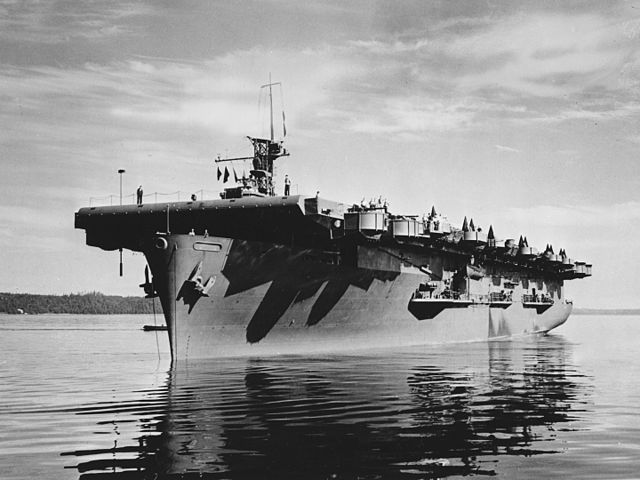
USS Casablanca at Puget Sound, July 1943, freshly completed.
Construction of this famous lead ship was awarded to Kaiser in Vancouver, Washington as seen, with a contract signed on 18 June 1942 and symbol given AVG-55, as she was already the 55th escort carrier ordered at this point for US alone.
On 20 August she became ACV-55, for “auxiliary”. Laid down on 3 November 1942 as originall (HMS) Ameer, via lend-lease she was known there MC hull 1092, first of 50 vessels, and there was a special ceremony with the director, company’s staff and many officials of the Maritime Commision and USN.
Note: I’ll spend a longer time on this one to showcase a typical career to the full. The next ships’s careers would be seen on a more succnt way.
On 23 February 1943, the second one, Liscome Bay, was transferred under lend-lease in place of ACV 55, and was renamed “Alazon Bay” (Alazan Bay in reality, Kleberg County, Texas) and changed again for Casablanca on 3 April 1942 as her sister was in between, renamed Lunga Point. Launched on 5 April that year, quickly built as promised, she was sponsored by no less than First Lady Mrs. Eleanor Roosevelt.
After a quick fitting out, always for that kind of ship, she was transferred to the Navy on 8 July and this time, officially commissioned on 15 July. Firts captain was Steven Ward Callaway. He was chosen as the one who will “write the book” for hundreds of captains on similars ships to follow.
It was however discovered during her sea trials a serious defect on her single propeller, both crippling speed and agility, so she was useless basically before being drydocked for replacement. Kaiser was not surprised in some ways as such teething problems were awaited; This ship was the first to hit water after all. For some time before being drydocked she was retained by the Navy as a training vessel in the Strait of Juan de Fuca, providing there too, a model of pilot certifications proper to these fifty carriers.
Until August 1944, she basically trained all carrier squadrons for the whole class and a training vessel for crews intended for the other Casablanca-class before commission, which took just two weeks between mastering the equipment and handle these. She also generatd tons of useful data on how she handled for prolonged periods at sea, general readiness and equipment’s use. Lessons learned were implemented on the fly on the new ships in construction;
By the summer of 1944 at last, USS Casablanca was drydocked to have her propeller corrected. Following certifications, she carried out at last her first war mission, departing on 24 August with personnel, airplanes, and aviation gasoline, from NAS Alameda (California), passing under the Golden Gate Bridge and off San Francisco before heading for Manus (Admiralty Islands). After a transport mission, taxiing aicraft and making at least her first long range mission she was back on 8 October 1944 to resume at Puget Sound her role as training carrier, as she was found quite valuable for the role. Due to this she had little occasion to see combat. She started to train pre-commissioning crews for the larger Commencement Bay-class also. A storm damaged her enough to need repairs in San Diego from 22 January 1945. On 12 February Captain John Lewis Murphy took command.
Back in the same role on 13 March, she was re-routed for a new transport mission, making a stop to Pearl Harbor, and proceeded to Guam, to unload part of her cargo, followed by another stop at Samar in the Philippines, but also Manus, and Palau. From 12 May she went back home to West Coast and her first overhaul, carrying bacl wounded personnel. They were mostly diverted to Pearl Harbor on 24 June. The summer of 1945 saw her transporting more personal and material to Pearl Harbor and Guam. While mud-way to the latter, the crew heard about Japan’s surrender.
By late 1945 she retook her old rolme as training carrier, providing pilot qualifications off Saipan and was later retrofitted into a troopship toparticipate in Operation Magic Carpet fleet, repatriating servicemen from around many locations in the pacific. She arrived in San Francisco on 24 September and was back in Pearl (September-October) for a second run to stopping at Espiritu Santo, Nouméa.
Her last run was between 8 December and 16 January 1946 (San Francisco-Yokohama). Back on the West Coast she departed on 23 January to Norfolk, and be mothballed in the Atlantic Reserve Fleet from 30 May 1946, then fully decommissioned on 10 June, struck on 3 July and sold on 23 April 1947 for scrap, to a Chester Company. Her active life had been of just three years, exemplifying the way the whole class was throught to be a quick wartime expedient and little else.
But the role she played out of harm was invaluable for the whole class, giving quick and efficient training on all crews, something few aicraft carriers procured in their active life but perhaps the British HMS Argus.
 USS Liscombe Bay (CVE-56)
USS Liscombe Bay (CVE-56)

USS Liscome Bay underway in 1945
USS Liscombe Bay (CVE-56) was named after a bay on Adak Island, in the Aleutian Islands. She was commissioned in April 1943.
After commission she moved to San Diego and than took aboard 60 aircraft before proceeding to San Francisco followed by training operations. On 11 October 1943, she became flagship, Carrier Division 24 (Rear Admiral Henry M. Mullinnix). On the 14th she received her air group and departed for Pearl Harbor, arriving on 27 October. After additional drills she was sent to join the invasion fleet of Operation Kourbash as part of Task Force 52 (RADM Richmond K. Turner), to the Gilbert Islands, her first and last mission.
USS Liscome Bay supported the invasion of Makin and proceeded to various bombardments with her air group on 20 November until Tarawa and Makin were captured. For more than 72h, her air group provided constant close air support, bombing Japanese positions, making 2,278 sorties. As part of Operation Galvanic they strafed and bombed airbases, and were called for quick support in ground operations as well as providing CAP for the landing area. USS Liscome Bay stayed with the rest of her task force to support Marines still fighting on Butaritari, whereas the rest of the fleet retired.
The invasion scrambled Admiral Mineichi Koga to send four Japanese submarines preying southwest of Hawaii, five near Truk and Rabaul to the Gilberts. Nine Japanese submarines were underway, but soon six were lost.
On 23 November I-175 (Lieutenant Commander Sunao Tabata) arrived off Makin and spotted the three escort carriers. She approached from 20 mi (32 km) southwest of Butaritari at 15 knots while the TG was traveling in a circular formation, seven destroyers, USS Baltimore, USS Pennsylvania, New Mexico, Mississippi, surrounding the three carriers. Liscome Bay was just in the center. But due to the risk of collisions they were not zig-zagging.
At 04:34, 24 November the destroyer USS Franks investigated a signal beacon, dropped from a Japanese plane, creating a screen gap and soon radar operators on New Mexico spotted a small blip (I-175 CT as she dove into position) and flight quarters were sounded at 04:50, but the crew returned to routine general quarters at 05:05 as 13 planes were prepared for dawn launching, readied on the flight deck, fueled and armed. Seven more were in the hangar but not readied, still she had a lot ammunitions stored below decks. Just as the TG made its turn to the northeast USS Liscome Bay had her side exposed to I-175, which fired a spread of three Type 95 “long lance” torpedoes.
At 05:10, the starboard lookout reported the torpedo wake, but there was little to do. It struck behind the aft engine room just as the carrier was turning, a lucky hit which detonated the bomb magazine. The resulting explosion created daylight over the whole area, with a mushroom nearly half a mile high, engulfing the ship. Shrapnel rained down 5,000 yards (4,600 m) away all around. New Mexico, just 1,500 yards (1,400 m) off had a fire starting by falling flaming debris, a sailor on USS Coral Sea being hit by… a fire extinguisher from Liscome Bay. The mushroom cloud above the ship soon reached several miles while nobody could see USS Liscome Bay anymore.
Her stern had been detached, clean through by the force of the detonation, the aft engine room was flooded instantly, the hangar and flight decks were heavily damaged, the superstructure and radar antenna collapsed on it, while a wild fire was soon out of control in the forward part of the hangar, igniting every planes parked on the flight deck which exploded in turn or fell off the deck. Fire-main pressure was lost an no pumps or fire fighting equipments worked. Other ammunition dumps soon started to detonate one after the other while gasoline was spread on the surrounding waters, catching fire. Thus, those jumping into the water had to escape underwater.
At 05:33, she listed to starboard and sink rapidly with still 53 officers and 591 salors and personal aboard. The list included Captain Irving Wiltsie, Rear Admiral Henry M. Mullinnix, Doris Miller.
The rest of the task group started evasive maneuvers, and at 05:40, USS Morris, Hughes and Hull arrived to the rescue, only catching men dead or dying. At 06:10 USS Maury spotted two torpedo wakes, 15 yards (14 m) from her while USS New Mexico’s radar operator spotted another echo, Hull and Gridley chaging on it. Macdonough went back to rescue a few more survivors until 08:00. In all 272 survived, albeit badly burnt or injured by shrapnel. This was more casulaties than the entire Japanese garrison on Makin.
On 4 February 1944, I-175 was detected and sunk by USS Charrette and Fair.
 USS Anzio (Coral Sea) (CVE-57)
USS Anzio (Coral Sea) (CVE-57)
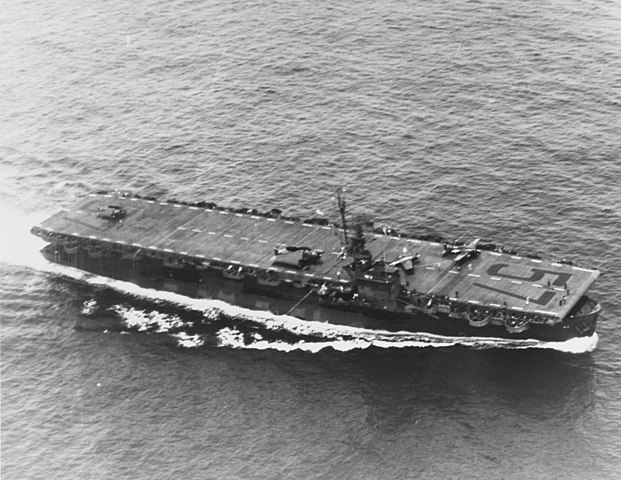
USS Anzio (CVE-57), ex Coral Sea underway.
USS Anzio (CVE-57) was a Casablanca-class escort carrier of the United States Navy. The ship was named after the Battle of Anzio, a World War II battle in Italy. She was commissioned in March 1944 and served in the Pacific theater of operations during World War II.
Anzio first saw action during the Marianas campaign in June 1944, providing air support for the invasion of Saipan. The ship also participated in the Battle of Leyte Gulf in October 1944, where she provided air cover for the invasion of the Philippines.
In 1945, Anzio was assigned to the Western Pacific, where she took part in the Okinawa campaign. During this campaign, she was attacked by a kamikaze plane on April 12, 1945, but managed to avoid serious damage.
After the war, Anzio was used to transport US servicemen back home. She was decommissioned in April 1946 and later sold for scrap in 1959.
 USS Corregidor (CVE-58)
USS Corregidor (CVE-58)

USS Corregidor (CVE-58) was a Casablanca-class escort carrier of the United States Navy. She was named after the Battle of Corregidor, a significant battle fought during the early stages of World War II in the Pacific.
Corregidor was commissioned in May 1944 and initially served as an escort carrier for convoys in the Atlantic. In August of that year, she was transferred to the Pacific theater of operations and provided air support for the invasion of the Palau Islands in September.
The ship also participated in the Battle of Leyte Gulf in October 1944, where she provided air cover for the landing forces in Leyte. In November, Corregidor supported the landings at Ormoc Bay, and then took part in the invasion of Lingayen Gulf in January 1945.
After the end of the war, Corregidor was used to transport US servicemen back home. She was decommissioned in March 1946 and later sold for scrap in 1959.
 USS Mission Bay (CVE-59)
USS Mission Bay (CVE-59)

USS Mission Bay (CVE-59) was a Casablanca-class escort carrier of the United States Navy. She was commissioned in October 1944 and named after Mission Bay, a large man-made saltwater lagoon in San Diego, California.
During World War II, Mission Bay served in the Pacific theater of operations and participated in the invasion of the Philippines in December 1944. The ship also took part in the Battle of Okinawa in April 1945, where she provided air support for the landings and conducted anti-submarine patrols.
After the war, Mission Bay was used to transport US servicemen back home. She was decommissioned in June 1946 and placed in reserve. In 1951, the ship was reactivated and converted into an amphibious assault ship, redesignated as LPH-6. She served in the Korean War and the Vietnam War before being decommissioned in 1970 and sold for scrap in 1971.
 USS Guadalcanal (CVE-60)
USS Guadalcanal (CVE-60)
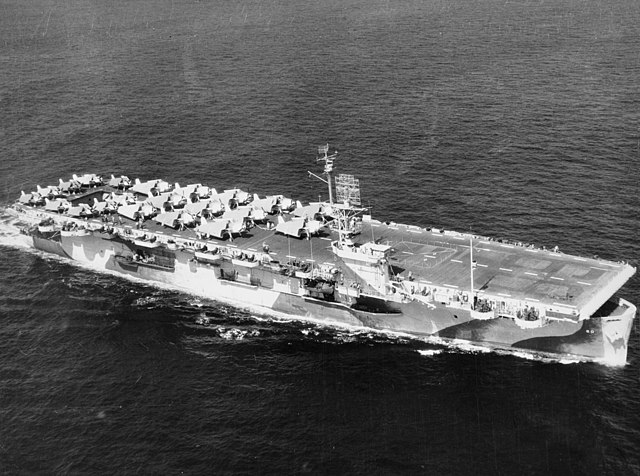
USS Guadalcanal underway 28 September 1944.
USS Guadalcanal (CVE-60) was a Casablanca-class escort carrier of the United States Navy. She was named after the Battle of Guadalcanal, a significant battle fought during the early stages of World War II in the Pacific.
Guadalcanal was commissioned in March 1944. In September of that year, she was transferred to the Pacific theater of operations and took part in the invasion of Leyte in the Philippines.
The ship also participated in the Battle of Leyte Gulf in October 1944, where she played a significant role in the sinking of the Japanese battleship Musashi. In January 1945, Guadalcanal took part in the invasion of Luzon in the Philippines and provided air support for the landings.
After the end of the war, Guadalcanal was used to transport US servicemen back home. She was decommissioned in January 1947 and later sold for scrap in 1959.
 USS Manila Bay (CVE-61)
USS Manila Bay (CVE-61)
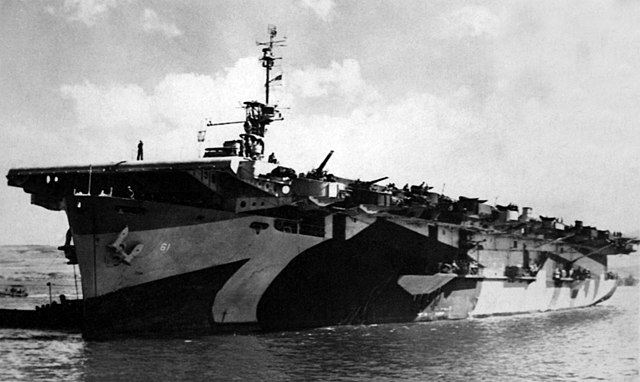
USS Manila Bay (CVE-61) was a Casablanca-class escort carrier of the United States Navy. She was named after the Battle of Manila Bay, a significant naval battle fought during the Spanish-American War in 1898.
Manila Bay was commissioned in May 1944. In December of that year, she was transferred to the Pacific theater of operations and took part in the invasion of Lingayen Gulf in the Philippines in January 1945.
The ship also participated in the Okinawa campaign, where she provided air support for the landings and conducted anti-submarine patrols. In July 1945, Manila Bay was present during the initial occupation of Tokyo Bay.
After the end of the war, Manila Bay was used to transport US servicemen back home. She was decommissioned in May 1946 and later sold for scrap in 1960.
 USS Natoma Bay (CVE-62)
USS Natoma Bay (CVE-62)
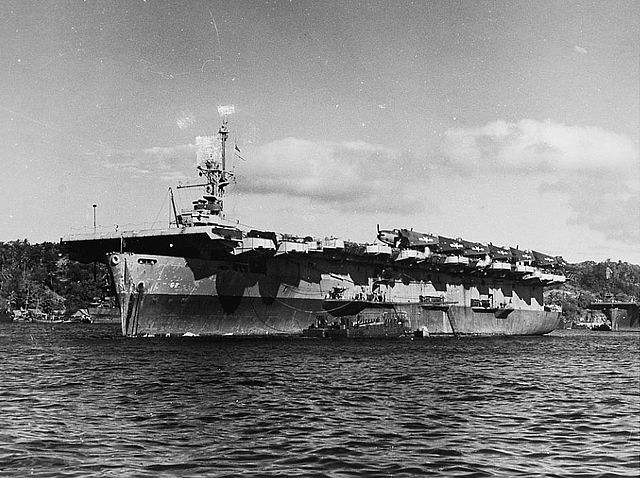
USS Natoma Bay (CVE-62) was a Casablanca-class escort carrier of the United States Navy. She was named after Natoma Bay, a small bay on the coast of California.
Natoma Bay was commissioned in July 1943 and initially served in the Atlantic, providing air support for convoys and conducting anti-submarine patrols. In November 1943, the ship was transferred to the Pacific theater of operations.
During World War II, Natoma Bay participated in a number of operations, including the Battle of the Philippine Sea, the invasion of Peleliu, and the Battle of Leyte Gulf. She also provided air support for the landings at Lingayen Gulf and Okinawa.
After the end of the war, Natoma Bay was used to transport US servicemen back home. She was decommissioned in March 1946 and placed in reserve. In 1951, the ship was reactivated and converted into an amphibious assault ship, redesignated as LPH-8. She served in the Korean War and the Vietnam War before being decommissioned in 1970 and sold for scrap in 1971.
 USS St. Lo (CVE-63)
USS St. Lo (CVE-63)
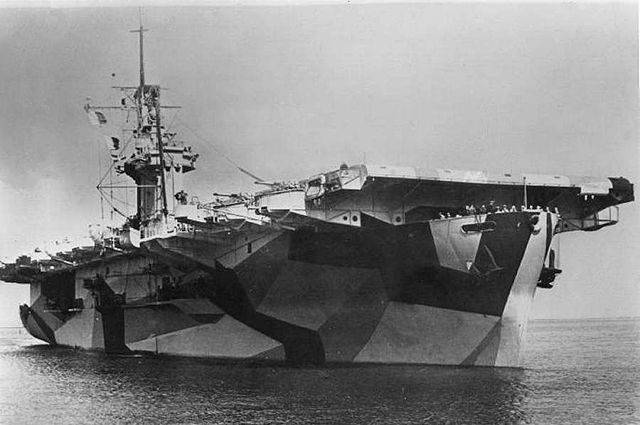
USS St. Lo (CVE-63) was named after the Battle of Saint-Lô during the Normandy Campaign, commissioned on 23 October 1943 as USS Midway and renamed on 10 October about the battle. She also freed the name for the Midway armored carrier class. She would be the first and last ship in the USN bearing that name. As USS Midway, she left Astoria in Oregon on 13 November 1943, made her sea trials, shakdown cruise, and went back to dry dock post-fixes on 10 April 1944. She made a new shakedown on the west coast and two trips to Pearl Harbor and one to Australia carrying aircraft. At last for her 4th trip she departed wit the Composite Squadron 65 (VC-65) and met Rear Admiral Gerald F. Bogan’s Carrier Support Group 1 in June 1944, ready for the Mariana Islands campaign. During the trip she covered the convoy and once arrived started a serie of airstrikes on Saipan with her FM-2 Wildcats claiming their first 4 kills, damagine one more dueing their combat air patrol (CAP).
On 13 July 1944, she was sent in Eniwetok, for replenishment and on the 23th she sailed for the invasion of Tinian wit the same combined air support and CAP plus ASW patrol (ASP), and operated off Tinian until returning for supplies at Eniwetok on 28 July.
USS Midway remained in Eniwetok Atoll until departing on 9 August for Seeadler Harbor, Manus, in the Admiralty Islands.
On 13 September, she ws assigned to TF 77 for the invasion of Morotai. Two days after her air group sorties for air strikes and close support of troops ashore until the 22th. In after a refueling she resumed air operations in the Palaus and was back to the new forward resupply base (FRB) in Seeadler Harbor on 3 October, learnign she had been renamed USS St. Lo. (probably with some frustration by the crew) Communication codes had to be changed but pennant remained the same. At least the crew was briefed after the Battle of Saint-Lô which happened on 18 July 1944. Soon, her career was to end, but nobody knew at the time. Her service has been relatively “cushy” without much Japanese opposition until then. But it’s ironic that she was lost just a couple of weeks under her new name.
St. Lo departed Seeadler Harbor on 12 October to take part in the invasion of Leyte with the same mission, convoy air coverage, air strikes on arrival, close air support, CAP and ASP. This commenced on 18 October. Her area of operation was Tacloban, northeast of Leyte under command of Rear Admiral Clifton Sprague in a unit known as “Taffy 3” (TU 77.4.3) with six other escort carriers of her class (including Gambier Bay) and three destroyers, four destroyer escorts as their only defence. St. Lo was off the east coasts of Leyte and Samar launching strikes on 18 to 24 October between concentratons, installations and airfields.
Before dawn, 25 October while about 60 mi east of Samar USS St. Lo launched four Avengers deployed in ASP and prepared her air group for the initial airstrikes of the beaches. The Battle started at 06:47. Her ASP would play a role in these events as it’s Ensign Bill Brooks, pilot of one of these TBF Avengers which first spotted and reported the large “Center Force” (Vice Admiral Takeo Kurita) approaching from the west-northwest, just 17 miles away. Lookouts on St. Lo also reported one of the famous “pagoda-like” superstructures on the horizon, likeli from IJN Kongo. A dedperate call was made by Rear Admiral Sprague which ordered Taffy 3 to turn south at full speed. But with only at best 19 kts, the carriers were not aboit the cut it. Kurita closed in and opened fire at 06:58.
Immediately all air groups engaged in ground support were redirected to Kurita’s force. They had to brave their AA and attacked them, using at best the surrounding rain squalls to hide and emerge for new passed, landing to resupply and taking off again with every ordnance they possesses. This went on with all available plane and with the order to proceed to Tacloban airstrip to rearm and refuel as carriers were now managing to dodge salvos, making landings impossible.
At 08:00, the heavy cruisers were racibg forward, closing in on USS St. Lo’s abnd closing by her port quarter, at 14,000 yd (13,000 m) when starting precision furing, while the carrier answered with her only 5 in (127 mm) gun (claiming three hits on IJN Tone).
There was a 90 minutes mayhem, only interrupted by desperate destroyers attacks and smoke cover. Kurita’s forward forces closed to 10,000 yd (9,100 m) bot on her port and starboard quarters straddling her when she was visible through smoke screens. Kurita’s efforts were marred by these smoke screens, destroyer and attacks combined, having suddenly to change course or dodge ordnance. Soon aicraft arrived from Taffy 2 too in the south, ans those of Taffy 1 were also ordered to arrive asap.
Eventually the IJN cruisers and destroyers broke off, turning tail at 09:20. At 10:50, as St.Lô seemed saved, the Shikishima “Special Attack” (Kamikaze) Unit entered the fray. For 40 minutes they targeted the six carries despite fierce AA opposition and except USS Fanshaw Bay, they were all hit. St Lo was hit by a single A6M2 Zero (presumably Lt. Yukio Seki) which crashed on her flight deck at 10:51, after been deviated from over USS White Plains by AA damage. The fighter was carrying a bomb which in effect penetrated the thin flight deck, exploding on the hangar port side, meeting countless aircraft being refueled and rearmed.
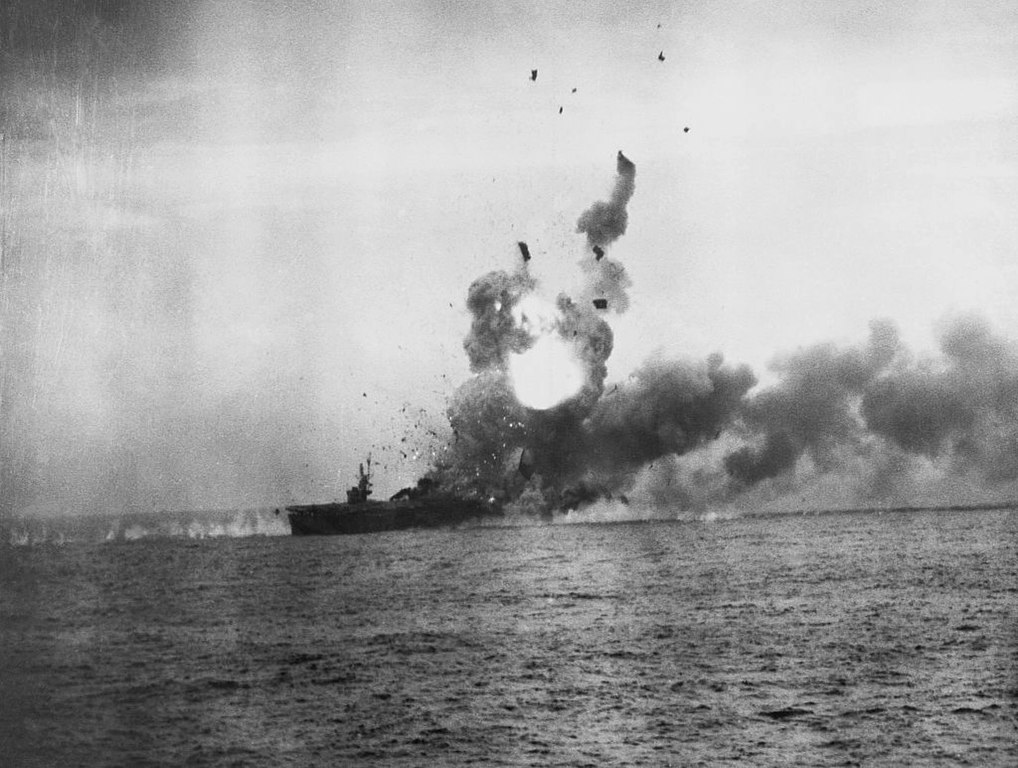
The world’s famous photo showing “St Lô explosion”. This was not the resulting explosion but the initial strike of the Kamikaze. She was rocked afterwards by a serie of equally violent deflagrations caused by the cookoff of so many ordnance in the hangar, fuelled by high-octane aviation gasoline. The first major explosion following created a fireball rising 300 feet above the flight deck with the largest object seen above that fireball being aft aircraft elevator, sent to 1,000 feet above. The photo (which was soon on life magazine cover) was taken by a combat cameraman aboard USS Kalinin Bay (CVE-68). It is now open source, part of the USN collection and library of congress collection. It has been featured in countless books and documentaries, as the most iconic picture of the Battle of Leyte.
Unsurpringly gasoline fire started, ingniting all fuel lines and live ammunition stockpiles causing secondary explosions, until reaching the torpedo and bomb magazine wich caused a massive deflagration, with a mushroom hundreds of feets high (as caught by a world-famous photo) which sealed the fate of USS St. Lo: She sank 30 minutes later, carrying with her 113. Of the rather numerous survivors fortunately, sadly 30 more would later die of their burning wounds. USS Heermann, John C. Butler, Raymond and Dennis picked up 434 survivors that day. More were rescued later. USS St. Lô was the only carrier to be lost after a Kamikaze attack that day. Today, the wreckage of St. Lo is a popular dive site off the coast of the Philippines, where she sank.
 USS Tripoli (CVE-64)
USS Tripoli (CVE-64)

USS Tripoli (CVE-64) was a Casablanca-class escort carrier of the United States Navy, named after the Battle of Tripoli during the First Barbary War.
Tripoli was commissioned in April 1944 and served in the Pacific theater of operations during World War II. She participated in the Battle of Leyte Gulf, providing air support for the landings in the Philippines, and later in the Battle of Okinawa.
After the end of the war, Tripoli was used to transport US servicemen back home. She was decommissioned in March 1946 and placed in reserve.
In 1950, Tripoli was recommissioned and served in the Korean War, providing air support for ground troops and conducting anti-submarine patrols. In 1958, the ship was converted into an amphibious assault ship, redesignated as LPH-10.
Tripoli served in the Vietnam War and was involved in the Mayaguez incident in 1975, where she provided support for the rescue of the SS Mayaguez, a US merchant ship seized by Khmer Rouge forces off the coast of Cambodia. She was decommissioned in 1995 and sold for scrap in 2000.
 USS Wake Island (CVE-65)
USS Wake Island (CVE-65)
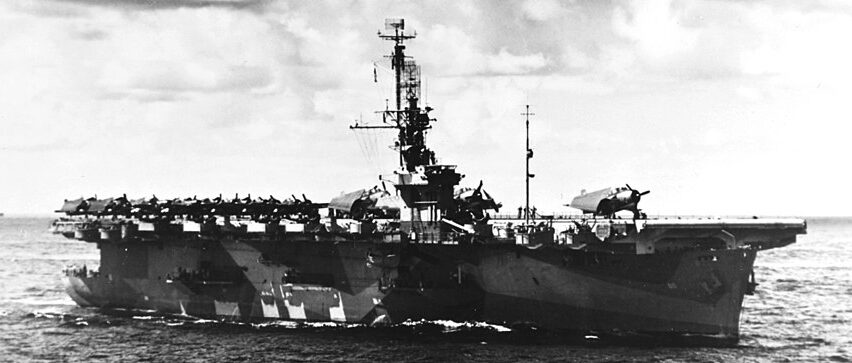
USS Wake Island (CVE-65) was a Casablanca-class escort carrier of the United States Navy, named after Wake Island, a coral atoll in the Pacific Ocean.
Wake Island was commissioned in July 1944 and initially served in the Atlantic, providing air support for convoys and conducting anti-submarine patrols. In November of that year, she was transferred to the Pacific theater of operations.
During World War II, Wake Island participated in a number of operations, including the Battle of Iwo Jima and the Battle of Okinawa, where she provided air support for the landings.
After the end of the war, Wake Island was used to transport US servicemen back home. She was decommissioned in June 1946 and placed in reserve.
In 1954, Wake Island was transferred to the French Navy, where she served as Dixmude. She was decommissioned in 1960 and later scrapped.
 USS White Plains (CVE-66)
USS White Plains (CVE-66)

USS White Plains (CVE-66) was a Casablanca-class escort carrier of the United States Navy, named after the city of White Plains, New York.
White Plains was commissioned in November 1944 and served in the Pacific theater of operations during World War II. She participated in the Battle of Okinawa, where she provided air support for the landings and conducted anti-submarine patrols.
After the end of the war, White Plains was used to transport US servicemen back home. She was decommissioned in February 1947 and placed in reserve.
In 1951, White Plains was recommissioned and served in the Korean War, providing air support for ground troops and conducting anti-submarine patrols. She was decommissioned in 1964 and scrapped in 1967.
 USS Solomons (CVE-67)
USS Solomons (CVE-67)
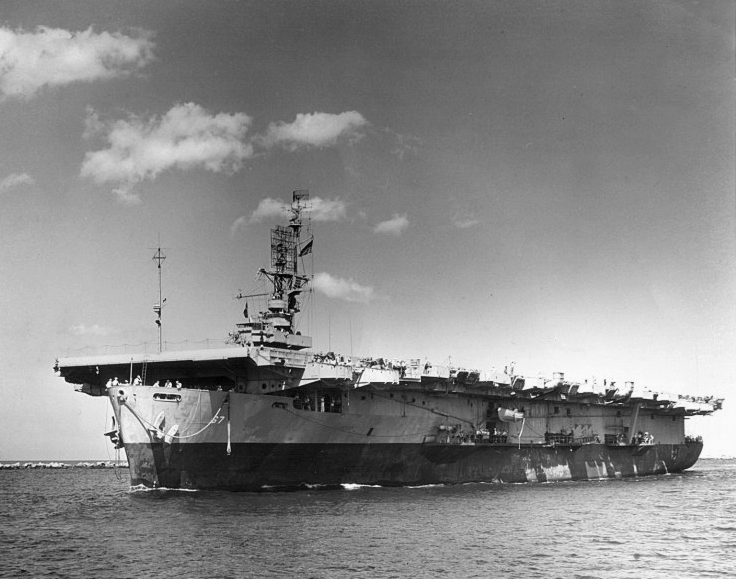
The USS Solomons (CVE-67) was a Casablanca-class escort carrier that served in the United States Navy during World War II. The ship was named after the Battle of the Solomon Islands, which was fought in the Pacific Theater of World War II.
The USS Solomons was commissioned on December 23, 1943, and began its service as an escort carrier in the Atlantic Ocean, providing air support for convoys heading to Europe. In March 1944, the ship was transferred to the Pacific Theater, where it participated in the invasion of the Mariana Islands and provided air cover for the landings on Saipan, Tinian, and Guam.
In October 1944, the USS Solomons participated in the Battle of Leyte Gulf, which was the largest naval battle in history. The ship provided air cover for the Allied forces during the battle and was credited with shooting down several enemy aircraft.
After the war ended, the USS Solomons was decommissioned in March 1946 and placed in reserve. The ship was later reactivated during the Korean War and served as a transport vessel, carrying troops and supplies to the Korean Peninsula. The USS Solomons was finally decommissioned in May 1958 and was sold for scrap in 1960.
 USS Kalinin Bay (CVE-68)
USS Kalinin Bay (CVE-68)
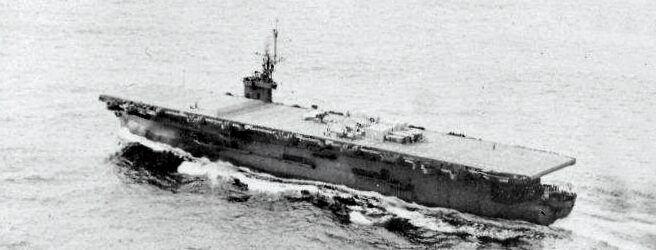
USS Kalinin Bay (CVE-68) was a Casablanca-class escort carrier that served in the United States Navy during World War II. The ship was named after Kalinin Bay, a bay in Alaska.
USS Kalinin Bay was laid down on September 10, 1942, at the Kaiser Shipyards in Vancouver, Washington, and was launched on December 19, 1942. The ship was commissioned on March 27, 1943, with Captain Francis T. Ward as her commanding officer.
After completing her shakedown cruise, Kalinin Bay was assigned to Task Force 52, which provided air support for the invasion of the Marshall Islands. The ship then took part in the campaigns in the Marianas, Palau, and the Philippines, where she was credited with shooting down numerous enemy aircraft.
On November 25, 1944, Kalinin Bay was attacked by a kamikaze aircraft during the Battle of Leyte Gulf. The ship suffered heavy damage, with 13 crew members killed and 60 wounded. However, the ship’s crew was able to save the ship and return her to service.
After repairs, Kalinin Bay returned to the Pacific theater and participated in the Okinawa campaign. The ship was decommissioned on April 17, 1946, and was sold for scrap in 1947.
USS Kalinin Bay received six battle stars for her service during World War II.
 USS Kassan Bay (CVE-69)
USS Kassan Bay (CVE-69)
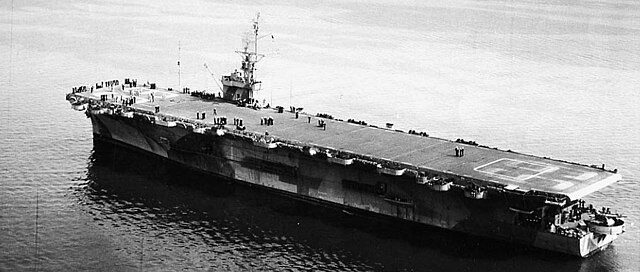
USS Kassan Bay (CVE-55) was a Casablanca-class escort carrier that served in the United States Navy during World War II. The ship was named after Kasaan Bay, a bay in Alaska.
Kassan Bay was launched on May 1, 1943, at the Kaiser Shipyards in Vancouver, Washington, and was commissioned on August 23, 1943, with Captain William D. Sample as her commanding officer.
After completing her shakedown cruise, Kassan Bay was assigned to Task Force 52, which provided air support for the invasion of the Marshall Islands. The ship then took part in the campaigns in the Marianas, Palau, and the Philippines, where she was credited with shooting down numerous enemy aircraft.
In October 1944, Kassan Bay was part of Task Force 38, which supported the invasion of Leyte in the Philippines. During this time, the ship participated in the Battle off Samar, where she provided air support to the escort carriers and destroyers that were being attacked by a much larger Japanese force. Kassan Bay was credited with shooting down several enemy planes during this battle.
After the war, Kassan Bay was used to transport troops and equipment back to the United States. The ship was decommissioned on April 17, 1946, and was sold for scrap in 1947.
USS Kassan Bay received four battle stars for her service during World War II.
 USS Fanshaw Bay (CVE-70)
USS Fanshaw Bay (CVE-70)
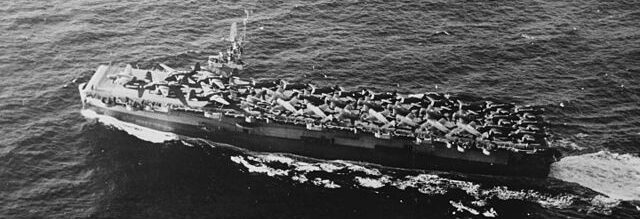
USS Fanshaw Bay (CVE-70) was commissioned on December 22, 1943, and was named after Fanshaw Bay, a bay in Alaska. The ship was built by the Kaiser Shipbuilding Company in Vancouver, Washington.
After completing her shakedown cruise, Fanshaw Bay was assigned to Task Force 52, which provided air support for the invasion of the Marshall Islands. The ship then participated in the campaigns in the Marianas, Palau, and the Philippines, where she was credited with shooting down numerous enemy aircraft.
During the Battle off Samar in October 1944, Fanshaw Bay was part of Task Unit 77.4.3, which was composed of six escort carriers and their escorting destroyers. Despite being heavily outgunned by the Japanese force, the escort carriers and destroyers fought valiantly to protect the landing forces at Leyte. Fanshaw Bay was hit by a kamikaze during the battle but was able to continue her operations.
After the war, Fanshaw Bay was used to transport troops and equipment back to the United States. The ship was decommissioned on April 30, 1946, and was sold for scrap in 1947.
USS Fanshaw Bay received six battle stars for her service during World War II.
 USS Kitkun Bay (CVE-71)
USS Kitkun Bay (CVE-71)

USS Kitkun Bay (CVE-71) was a Casablanca-class escort carrier that served in the United States Navy during World War II. The ship was named after Kitkun Bay, a bay in Alaska.
Kitkun Bay was launched on February 5, 1944, at the Kaiser Shipyards in Vancouver, Washington, and was commissioned on April 1, 1944, with Captain Henry Farrow as her commanding officer.
After completing her shakedown cruise, Kitkun Bay was assigned to Task Force 58 and participated in the Mariana and Palau Islands campaign. She then provided air support for the Leyte and Luzon campaigns in the Philippines.
During the Battle off Samar on October 25, 1944, Kitkun Bay was part of Task Unit 77.4.3, which was composed of six escort carriers and their escorting destroyers. Despite being heavily outnumbered by the Japanese force, the escort carriers and destroyers fought fiercely to protect the landing forces at Leyte. Kitkun Bay was hit by a kamikaze during the battle, but her crew was able to contain the damage and keep the ship afloat.
After repairs, Kitkun Bay returned to action and participated in the Okinawa campaign. She also transported troops and supplies back to the United States after the war. The ship was decommissioned on May 1, 1946, and was sold for scrap in 1947.
USS Kitkun Bay received six battle stars for her service during World War II.
 USS Tulagi (CVE-72)
USS Tulagi (CVE-72)

USS Tulagi (CVE-72) was a Casablanca-class escort carrier that served in the United States Navy during World War II. The ship was named after the Battle of Tulagi, which took place during the Guadalcanal campaign in the Pacific.
Tulagi was launched on April 7, 1944, at the Kaiser Shipyards in Vancouver, Washington, and was commissioned on May 22, 1944, with Captain Walter H. Price as her commanding officer.
After completing her shakedown cruise, Tulagi was assigned to Task Force 38 and participated in the Philippines campaign, providing air support for the landings at Leyte and Luzon. She was then assigned to Task Force 58 and took part in the Okinawa campaign.
During the Battle of Okinawa, Tulagi’s aircraft were involved in numerous air strikes against Japanese positions on the island. She also served as a rescue ship for downed pilots and provided anti-submarine patrols to protect the fleet from enemy submarines.
After the war, Tulagi was used to transport troops and equipment back to the United States. The ship was decommissioned on April 5, 1946, and was sold for scrap in 1947.
USS Tulagi received two battle stars for her service during World War II.
 USS Gambier Bay (CVE-73)
USS Gambier Bay (CVE-73)
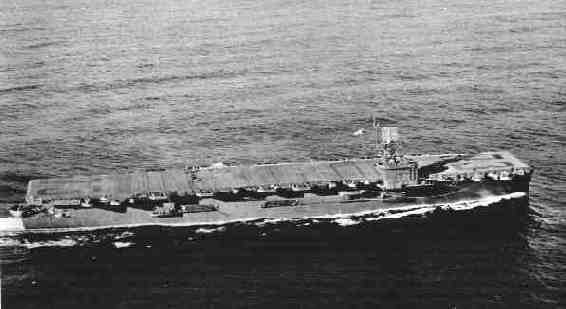
USS Gambier Bay (CVE-73) was named after Gambier Bay, a bay in Alaska. She was launched on November 22, 1943 at the Kaiser Shipyards in Vancouver, Washington, and was commissioned on December 17, 1943, with Captain Hugh H. Goodwin Jr. as her commanding officer.
After completing her shakedown cruise off San Diego, Gambier Bay was assigned to Task Group 52.2. On 7 February 1944 she sailed with 400 troops embarked for Pearl Harbor, and later rendezvous off the Marshall island. Her escort was the destroyer USS Norman Scott. She was also a taxi, flying 84 replacement planes for USS Enterprise. Back to San Diego via Pearl Harbor she carried aircraft in need of repairs, and qualified carrier pilots to Southern California. On 1 May 1944 she departed again, this time to join Rear Admiral Harold B. Sallada at the head of TG 52.11 for the Marshalls and invasion of the Marianas.
USS Gambier Bay there was tasked of close air support during the initial landings, for the Marines on Saipan, 15 June 1944. Her air group looked for enemy gun emplacements and troops as well as vehicles, all targets of opportunity. On the 17th, her combat air patrol managed to repel an attack of 47 enemy planes. In addition to the plane shot down, her gunners claimed two of the three attacking her.
The feat was repeated the following day, and the antiaircraft fire of the entire task group was even more intense. In all the eight pilots from VC-10 (composited) shared kills with the rest of the carriers and repulsed the attack with no loss. USS Gambier Bay stayed off Saipan for more CAPs and close support for the Marines. At the same time took place the Battle of the Philippine Sea. USS Gambier Bay was also present next at Tinian (19–31 July) and then Guam, for the same missions, until 11 August.
Both the ship received maintenance and the crew rest in the Marshalls. But on 15–28 September she was back supporting the assault on Peleliu and Angaur in the Southern Palaus. They were next sent to Hollandia in New Guinea, and Manus Island in the Admiralties, as invasion of the Philippines commenced. She was screened by four destroyer escorts shared with USS Kitkun Bay, tasked of escorting the transports and landing ships to Leyte Gulf. Next she was detached to join the escort carrier task uniy from Rear Admiral Clifton A. F. Sprague which assembled on 19 September off Leyte.
This TU comprised six escort carriers, three destroyers, four destroyer escorts, and had the radio call sign “Taffy 3”. This would become the most famopus unit in the whole three-days battle of Leyte that followed. The total force comprised indeed three groups of six-carrier task units. They were tasked ot maintain air supremacy over Leyte Gulf, eastern Leyte while TF-58 (Halsey) was the more mobile element, ready to pounce on any Japanese intervention. The invasion commenced and their air group caused havoc on the shore and inland, between enemy airfields and supply convoys to troop concentrations. The troops next received constant close air support, while a combat air patrolwas maintained. As the battle commenced, Taffy 1 and 2 were off northern Mindanao and off the entrance to Leyte Gulf while “Taffy 3” was off Samar.
The Japanese Southern Force was destroyed on 25 October in the Surigao Strait, the center force in Sibuyan Sea a day before was attacked by US Planes from Halsey’s Third Fleet, but the carriers were sent north to intercept the decoy carriers (Northern Force) off Cape Engaño. But the ruse worked, as meanwhile the Center force (presumed defeated by Halsey) sneaked in, just reinforced during the night, and comprising now four battleships, six heavy cruisers, two light cruisers, 11 destroyers. They passed San Bernardino Strait by night in the fog, proceeded along the coast of Samar and arrived at dawn in Leyte Gulf under a mixed sky, with a visibility of circa 40,000 yards (37 km), with low overcast, occasional rain squalls.
“Taffy 3” was caught off guard and made an urgent call for help. The escort carriers steamed eastward, launch planes and turned south seeking concealment in a heavy squall. The combined air groups attacked with all they had, torpedoes, bombs, strafing, until their ammunition ran out, and even went to “dry runs” (dummy attacks) when ordnance was done, just to keep the enemy formation busy and dispersed, in order to delay the advance. This was one of the several feats of bravery, gallantry and ultimate commitment in this extraordinary “last stand”.
Smoke was laid down by the destroyers to cover the carrier’s escape. They ducked in and out of it and also playing with occasional rain to to engage the fleet at point-blank range. There were losses, but their torpedo runs bear fruit. They were umtimately ordered back to cover the carriers with more smoke. But the Japanese, faster than the escort carriers, soon caught up and started to spot their targets: USS Gambier Bay was fired on first, hit by several ships at once. He single poop 5-inch (127 mm) gun fired nevertheless at a cruiser, without visible results, while destroyers Heermann and Johnston made a run to try to repel the Japanese, they paid dearly for it, being straddled by IJN Yamato, with the largest guns of the war in a rare surface action.
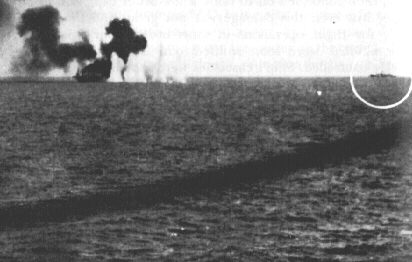
USS Gambier bay in flames. IJN Tone or Chikuma can be seen closing in for the coup de grace (right).
USS Gambier Bay was ultimately set alight, and as shells splash down beside her at 08:20, a heavy shell hit right through her forward engine room. Only capable of 9 knots, it’s either the heavy cruiser IJN Chikuma, or Yamato or Kongō which claimed the fatal hits as she went to a crawl. Tone and Chikuma closed until they could brought their AA to bear and complete the carnage. Abandon ship was ordered, and she ultimately capsized at 09:07, sank at 09:11, but had still 800 survivors, rescued two days later by landing and patrol crafts, albeit Sharks took their toll. 147 of the crew was never seen again. The same battle saw the loss of her sister USS St. Lo, the destroyers USS Hoel, Samuel B. Roberts, and Johnston. USS Gambier Bay became the one and only US Navy aircraft carrier sunk exclusively by surface gunfire.
Nevertheless, her air group was completed by Aircraft from “Taffy 2” and by 09:25 signalmen saw the whole Japanese fleet retiring. The “miracle of Samar”. Her Squadron and those of “Taffy 2” claimed with the destroyer’s help, three enemy cruisers and a lot of damage to the others in Center Force. USS Gambier Bay would later receive four battle stars for her service, shared the presidential Unit Citation for Taffy 3 “for extraordinary heroism in the Battle off Samar”. Captain Walter V. R. Vieweg received the Navy Cross for “extraordinary heroism”. XO Richard R. Ballinger received the Silver Star “for conscious gallantry and intrepidity”.
 USS Nehenta Bay (CVE-74)
USS Nehenta Bay (CVE-74)
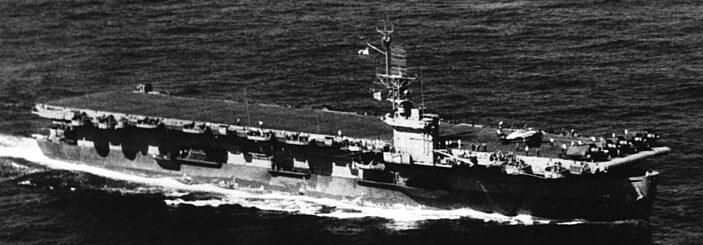
USS Nehenta Bay (CVE-74) was a Casablanca-class escort carrier that served in the United States Navy during World War II. The ship was named after Nehenta Bay, a bay in Alaska.
Nehenta Bay was launched on December 11, 1943, at the Kaiser Shipyards in Vancouver, Washington, and was commissioned on February 3, 1944, with Captain Donald J. Ramsey as her commanding officer.
After completing her shakedown cruise, Nehenta Bay was assigned to Task Group 52.2, which provided air support for the invasions of the Marshall Islands and the Marianas Islands. She then participated in the Battle of Leyte Gulf, providing air support for the landing forces at Leyte.
After the war, Nehenta Bay was used to transport troops and equipment back to the United States. The ship was decommissioned on March 27, 1946, and was placed in the Pacific Reserve Fleet.
In 1951, Nehenta Bay was reactivated and converted into an escort aircraft carrier (CVC-74). She was then assigned to the Pacific Fleet and participated in the Korean War, providing air support for ground forces and conducting anti-submarine patrols.
Nehenta Bay was decommissioned for the second time on March 1, 1955, and was sold for scrap in 1959.
USS Nehenta Bay received two battle stars for her service during World War II and one battle star for her service during the Korean War.
 USS Hoggatt Bay (CVE-75)
USS Hoggatt Bay (CVE-75)

USS Hoggatt Bay (CVE-75) was a Casablanca-class escort carrier that served in the United States Navy during World War II. The ship was named after Hoggatt Bay, a bay in Alaska.
Hoggatt Bay was launched on January 18, 1944, at the Kaiser Shipyards in Vancouver, Washington, and was commissioned on March 11, 1944, with Captain Joseph J. Clark as her commanding officer.
After completing her shakedown cruise, Hoggatt Bay was assigned to Task Group 52.2, which provided air support for the invasions of the Marshall Islands and the Marianas Islands. She then participated in the Battle of Leyte Gulf, providing air support for the landing forces at Leyte.
Hoggatt Bay was also involved in the Battle of Okinawa, providing air support for ground forces and conducting anti-submarine patrols.
After the war, Hoggatt Bay was used to transport troops and equipment back to the United States. The ship was decommissioned on April 3, 1946, and was placed in the Pacific Reserve Fleet.
In 1951, Hoggatt Bay was reactivated and converted into an escort aircraft carrier (CVC-75). She was then assigned to the Pacific Fleet and participated in the Korean War, providing air support for ground forces and conducting anti-submarine patrols.
Hoggatt Bay was decommissioned for the second time on March 1, 1955, and was sold for scrap in 1959.
USS Hoggatt Bay received two battle stars for her service during World War II and one battle star for her service during the Korean War.
 USS Kadashan Bay (CVE-76)
USS Kadashan Bay (CVE-76)

The U.S. Navy escort carrier USS Kadashan Bay (CVE-76) at San Francisco, California (USA), on 8 April 1945. She is painted in Camouflage Measure 21. Several Lockheed PV patrol bombers are carried on deck.
USS Kadashan Bay (CVE-76) was a Casablanca-class escort carrier that served in the United States Navy during World War II. The ship was named after Kadashan Bay, a bay in Alaska.
Kadashan Bay was launched on February 22, 1944, at the Kaiser Shipyards in Vancouver, Washington, and was commissioned on April 15, 1944, with Captain Miles T. McGettigan as her commanding officer.
After completing her shakedown cruise, Kadashan Bay was assigned to Task Group 52.2, which provided air support for the invasions of the Marshall Islands and the Marianas Islands. She then participated in the Battle of Leyte Gulf, providing air support for the landing forces at Leyte.
Kadashan Bay was also involved in the Battle of Okinawa, providing air support for ground forces and conducting anti-submarine patrols.
After the war, Kadashan Bay was used to transport troops and equipment back to the United States. The ship was decommissioned on June 1, 1946, and was placed in the Pacific Reserve Fleet.
In 1951, Kadashan Bay was reactivated and converted into an escort aircraft carrier (CVC-76). She was then assigned to the Pacific Fleet and participated in the Korean War, providing air support for ground forces and conducting anti-submarine patrols.
Kadashan Bay was decommissioned for the second time on March 1, 1955, and was sold for scrap in 1959.
USS Kadashan Bay received two battle stars for her service during World War II and one battle star for her service during the Korean War.
 USS Marcus Island (CVE-77)
USS Marcus Island (CVE-77)
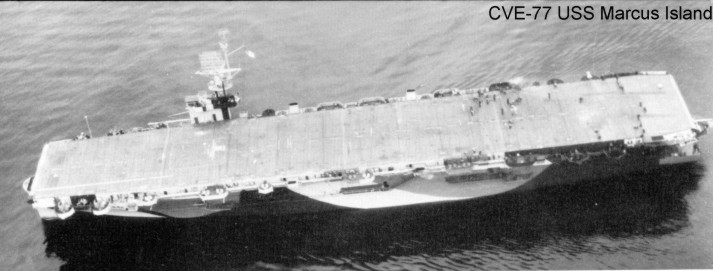
The USS Marcus Island (CVE-77) was an American aircraft carrier that served during World War II. She was named after Marcus Island, a small island in the western Pacific Ocean.
The ship was originally designed as a merchant tanker, but was converted into an escort carrier during construction. She was commissioned in November 1944 and served in the Pacific theater of the war, primarily providing air support for the Allied forces during the Battle of Okinawa.
The Marcus Island was part of Task Group 52.1, which was responsible for providing air cover for the amphibious forces landing on Okinawa. Her aircraft were used for reconnaissance, fighter cover, and ground attack missions.
After the war, the Marcus Island was used to transport American troops back to the United States. She was decommissioned in 1946 and placed in the reserve fleet. In 1959, she was sold for scrap.
During her service, the Marcus Island was awarded two battle stars for her participation in the Battle of Okinawa and the assault and occupation of Okinawa.
 USS Savo Island (CVE-78)
USS Savo Island (CVE-78)
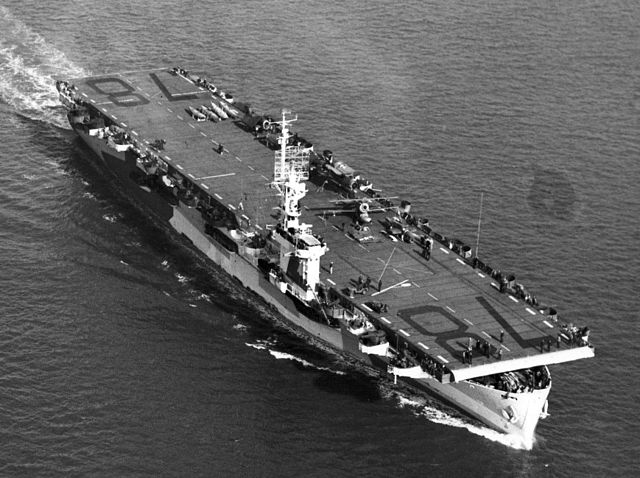
The USS Savo Island (CVE-78) was an American escort carrier that served during World War II. She was named after the Battle of Savo Island, a naval battle fought in 1942 during the Guadalcanal Campaign.
The Savo Island was commissioned in April 1944 and served in the Pacific theater of the war. She was assigned to Task Group 52.1, which was responsible for providing air support for the amphibious forces landing on the islands of the Pacific.
The ship’s aircraft were used for a variety of missions, including reconnaissance, fighter cover, and ground attack. The Savo Island participated in the Battle of Leyte Gulf in October 1944, providing air support for the American fleet during the largest naval battle of the war.
After the war, the Savo Island was used to transport American troops back to the United States. She was decommissioned in 1946 and placed in the reserve fleet. In 1959, she was sold for scrap.
During her service, the Savo Island was awarded two battle stars for her participation in the Battle of Leyte Gulf and the assault and occupation of Okinawa.
 USS Ommaney Bay (CVE-79)
USS Ommaney Bay (CVE-79)
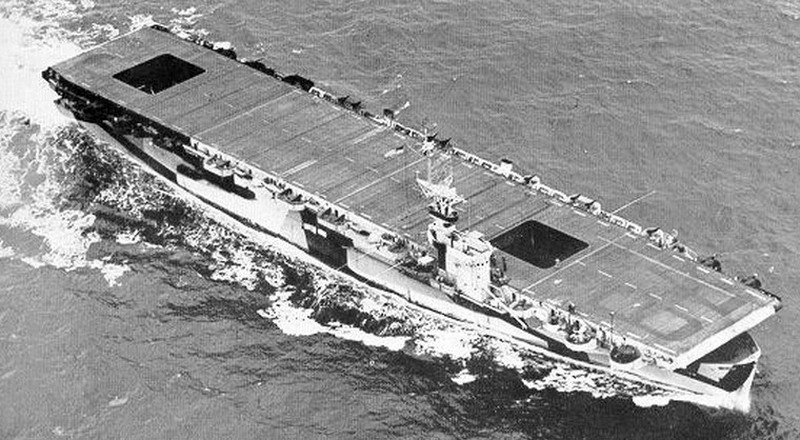
Ommaney Bay, after an area at the south end of Baranof Island, Alaska which was part of the Aleutian campaign, was commissioned on 11 February 1944 with Commodore Howard L. Young in command.
She had her sea trials, tests and fitting out at Astoria in Oregon, before a shakedown in Puget Sound and sailed on 19 March 1944 from Oakland to Brisbane in Australia, with passengers and cargo, including many replacement aircraft. On 27 April she was back in San Diego and started qualification of her own air group for ten days, with fleet drills. She had a few more alterations and repairs, until heading on 10 June for Pearl Harbor. Until 12 August she trained there before heading for Tulagi prepared for the invasion of the Palau Islands. From 11 September until early October she started combat operations off Peleliu and Angaur. On 18 September one of her TBM-1C short of on fuel landed onto Peleliu’s airfield, the first to do so, as troops were still securing the surroundings.
Next, the carrier was back in Manus Island for rest and dsplenishment, before reassigned to Rear Admiral Felix Stump and his TU 77.4.2 also known by its radio code “Taffy 2” on 22 October. In the south of Samar, started the invasion support operations. However on 25 October, 01:55, Admiral Thomas C. Kinkaid ordered the carriers to start reconnissances for any possibke IJN attack in a wide area around the invasion fleet at daybreak. Ommaney Bay took two hours to launch five fighters, seven torpedo bombers and they missed Vice-Admiral Takeo Kurita Center Force sneaking in. Where they were sent, they could have warned Taffy 3 well in advance and completely modify the battle. As the combat started, Taffy 2 soon rushed to help Taffy 3. Her airgroup has been credited with badly damaging IJN Chokai.
At 08:20, five Wildcats, six Avengers from Ommaney Bay attacked Mogami and also damaged her. 40 minutes later the Avengers joined 17 others crippling and sinking her for good three hours later as she was torpedoed by Akebono. This day saw the cxarrier launching six succesive attacks on the Japanese fleet with the rest of TG 77.4.1, largely responsible to turn the tide of a desperate fight. They appeared to have been more successful than destroyers, and fully confirming the navy that despite their small size, the escort carriers still could muster as much forces as any fleet carrier with the same effect if needed. Taffy 2 accepted aircraft from Taffy 3 due to the lost Gambier Bay and St Lo notably, or just low of fuel. She had to jettison her own aircraft to keep her flight deck operational. On 30 October, the battered, but victorious force retired for Manus, staying there for the most of November.
On 10 November as Ommaney Bay was docked in Seeadler Harbor, five miles (2.4 km) from the ammunition ship Mount Hood, she was suddenly rocked by the accidental explosion of the latter, one of the fiercest man-mande explosion in history. Sailors on deck were lifted off their feet by the blast, causing injuries, and soon after, compounded by the tidal wave provoked by the deflagration. While flamed fragments rained down, they oblied the safety crew to rapid extinguishing any start. On 12-17 December she was sent for various missions in Mindanao and the Sulu Sea for the invasion of Mindoro.
On 15 December the force was assaulted by 40 Japanese planes, kamikazes and escorts which came from former Clark Field and Davao, first reported at 7:00. The attack went on at 09:40, with one plunging with a bomb on Ommaney but missed, disengaging, two more missed and were shot down by Manila Bay and destroyer escorts. A single Yokosuka P1Y kamikaze however soon dove on Ommaney Bay from her port-bow side. The combined, directed AA fire from all ships eventually set it aloght 400yds (370 m) away and it crashed in the ocean, barely 27 m away. On 19 December she was back in respenihment. On 27 December she retutned for the landings at Lingayen Gulf, stopping at San Pedro Bay, and heading for the Sulu Sea on 3 January 1945.
On the afternoon of the following day, 4 January 1945 at 17:00 while underway in the Sulu Sea, her radar operator spotted 15 approaching Japanese planes 45 miles (72 km) away to the west, soon splitting into two groups to the rear and cented of the task group. All fighters were soon in the air, but their direction was plagued by false radar signals. In fact only army P-47 fighters intercepted and shoot down one. The one that escaped is believed to have sunk Ommaney Bay. This interception was not reported and at 17:12, a Yokosuka P1Y flying very low emerged and climbed, aiming at Ommaney Bay, approaching towards her bow. Captain Young confirmed the pilot was perfectly aware of his concelment, arriving in the blinding glare of the sun.
There were ten lookouts assigned on the island’s top open bridge with polaroid glasses in addition to the one on the signal platform. Without radar concept, the nearby USS New Mexico was was unable to react fast enough, when the plane arrived by complete surprise, slicing across the superstructure with its wing, which had everyone in the island plunging. Veering into the the flight deck, forward starboard side it released two bombs, one penetrating, detonating, and trigerring a serie of explosions. The second one crossed the hangar deck, rupturing the fire main and explosing in her starboard side. Water pressure forward lost, power, communications complicated matters, as the fire was now spreading fast thanks to a reuptured oil tank. The smoke became so thick all hope to combat fire in the hangar was abandoned.
Destroyers hesitated to close on Ommaney Bay to assist because of how firced and hot was the fire, knownin there was still plenty of ammunition aboard that can cookoff. After all, she was underway for an operation, at full ordnance capacity. USS Bell managed to get close enough to help fight fires with her pumps but collided. She started to evacuate the wounded at 17:45 but a few minutes afterwards the topside was just too hot. Stored torpedo warheads were signalled in the area which might be caught up by flames, and under threat to detonate when it was ordered to abandon ship. At 18:12, Captain Young was the last man to evacuate and an 18:18 as predicted, a fierce detonation followed, which collapsed the flight deck, projecting debris for miles around. She was scuttled by torpedoes at 19:58 from USS Burns. 95 sailors from Ommaney Bay were lost that day, plus 65 wounded. 7 more were killed during another kamikaze attack later. USS Shamrock Bay took her place for the operation in Lingayen Gulf.

Ommaney Bay burning after the attack (cropped)
The loss of Ommaney Bay highlighted the vulnerability of these escort carriers, not protected unline Independence and Essex class, to these types of attacks. This led the command to develop more effective countermeasures. But by all acounts the pilot of the Yokosuka P1Y was probably a veteran that knew perfectly what he was doing and achieved complete surprise, and success.
For her service USS Ommaney Bay was awarded one battle star.
 USS Petrof Bay (CVE-80)
USS Petrof Bay (CVE-80)
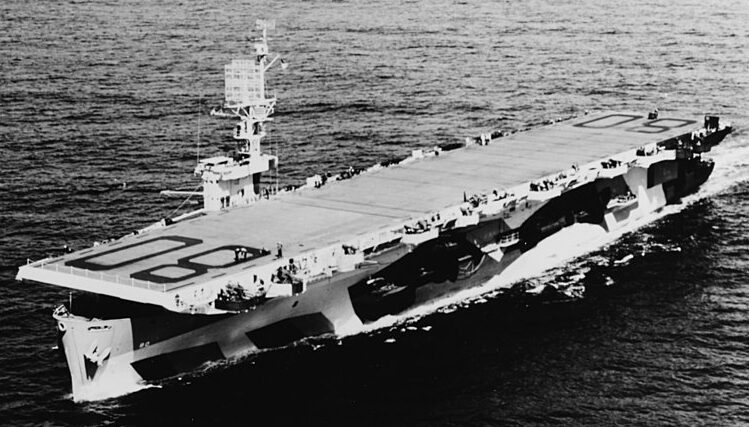
The USS Petrof Bay (CVE-80) was an American escort carrier that served during World War II. She was named after Petrof Bay, a bay on the coast of Alaska.
The Petrof Bay was commissioned in February 1944 and served in the Pacific theater of the war. She was assigned to Task Group 52.3, which was responsible for providing air support for the amphibious forces landing on the islands of the Pacific.
The ship’s aircraft were used for a variety of missions, including reconnaissance, fighter cover, and ground attack. The Petrof Bay participated in the Battle of Leyte Gulf in October 1944, providing air support for the American fleet during the largest naval battle of the war.
After the war, the Petrof Bay was used to transport American troops back to the United States. She was decommissioned in 1946 and placed in the reserve fleet. In 1960, she was sold for scrap.
During her service, the Petrof Bay was awarded four battle stars for her participation in the Leyte Gulf landings, the Mindoro landings, the Lingayen Gulf landings, and the assault and occupation of Okinawa.
 USS Rudyard Bay (CVE-81)
USS Rudyard Bay (CVE-81)
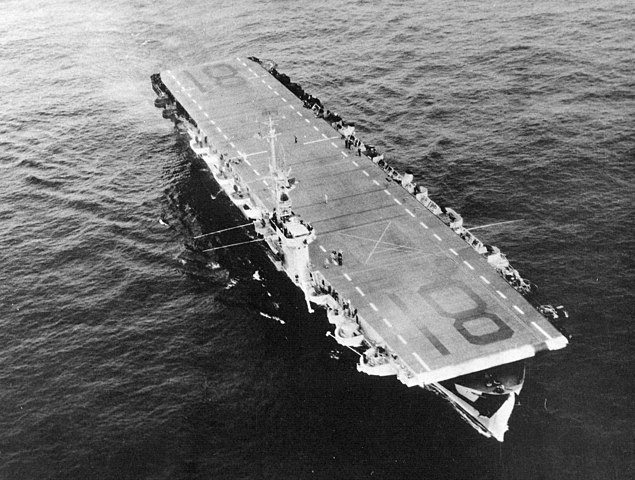
The USS Rudyard Bay (CVE-81) was an American escort carrier that served during World War II. She was named after Rudyard Bay, a bay on the coast of Alaska.
The Rudyard Bay was commissioned in March 1944 and served in the Pacific theater of the war. She was assigned to Task Group 77.4, which was responsible for providing air support for the Allied forces during the Battle of Okinawa.
The ship’s aircraft were used for a variety of missions, including reconnaissance, fighter cover, and ground attack. The Rudyard Bay was also used as a transport ship, carrying troops and supplies to various locations in the Pacific.
After the war, the Rudyard Bay was used to transport American troops back to the United States. She was decommissioned in 1946 and placed in the reserve fleet. In 1960, she was sold for scrap.
During her service, the Rudyard Bay was awarded one battle star for her participation in the assault and occupation of Okinawa.
 USS Saginaw Bay (CVE-82)
USS Saginaw Bay (CVE-82)

The USS Saginaw Bay (CVE-82) was an American escort carrier that served during World War II. She was named after Saginaw Bay, a bay on the eastern coast of Michigan.
The Saginaw Bay was commissioned in June 1944 and served in the Pacific theater of the war. She was assigned to Task Group 77.4, which was responsible for providing air support for the Allied forces during the Battle of Okinawa.
The ship’s aircraft were used for a variety of missions, including reconnaissance, fighter cover, and ground attack. The Saginaw Bay was also used as a transport ship, carrying troops and supplies to various locations in the Pacific.
After the war, the Saginaw Bay was used to transport American troops back to the United States. She was decommissioned in 1946 and placed in the reserve fleet. In 1959, she was sold for scrap.
During her service, the Saginaw Bay was awarded three battle stars for her participation in the Leyte Gulf landings, the Mindoro landings, and the assault and occupation of Okinawa.
 USS Sargent Bay (CVE-83)
USS Sargent Bay (CVE-83)

The USS Sargent Bay (CVE-83) was an American escort carrier that served during World War II. She was named after Sargent Bay, a bay on the coast of Alaska.
The Sargent Bay was commissioned in July 1944 and served in the Pacific theater of the war. She was assigned to Task Group 38.3, which was responsible for providing air support for the Allied forces during the Battle of Leyte Gulf.
The ship’s aircraft were used for a variety of missions, including reconnaissance, fighter cover, and ground attack. The Sargent Bay was also used as a transport ship, carrying troops and supplies to various locations in the Pacific.
On December 13, 1944, while supporting the invasion of Mindoro in the Philippines, the Sargent Bay was hit by a kamikaze attack. The resulting explosion and fires caused the ship to sink within an hour, with the loss of 87 crew members.
The Sargent Bay was the second American aircraft carrier to be sunk by a kamikaze attack. Her loss highlighted the vulnerability of American carriers to these types of attacks, and led to increased efforts to develop effective countermeasures.
For her service in World War II, the Sargent Bay was awarded two battle stars.
 USS Shamrock Bay (CVE-84)
USS Shamrock Bay (CVE-84)
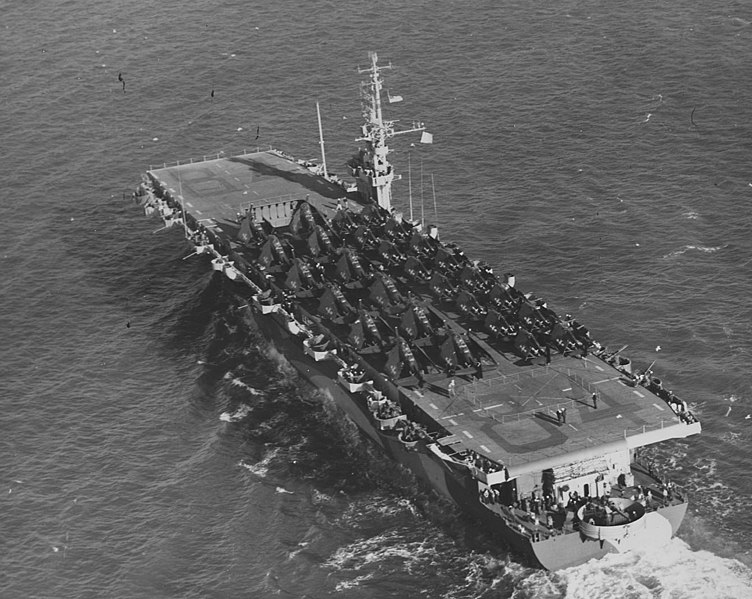
The USS Shamrock Bay (CVE-84) was an American escort carrier that served during World War II. She was named after Shamrock Bay, a bay on the coast of Alaska.
The Shamrock Bay was commissioned in August 1944 and served in the Pacific theater of the war. She was assigned to Task Group 77.4, which was responsible for providing air support for the Allied forces during the Battle of Okinawa.
The ship’s aircraft were used for a variety of missions, including reconnaissance, fighter cover, and ground attack. The Shamrock Bay was also used as a transport ship, carrying troops and supplies to various locations in the Pacific.
After the war, the Shamrock Bay was used to transport American troops back to the United States. She was decommissioned in 1946 and placed in the reserve fleet. In 1960, she was sold for scrap.
During her service, the Shamrock Bay was awarded two battle stars for her participation in the assault and occupation of Okinawa and the Third Fleet operations against Japan.
 USS Shipley Bay (CVE-85)
USS Shipley Bay (CVE-85)
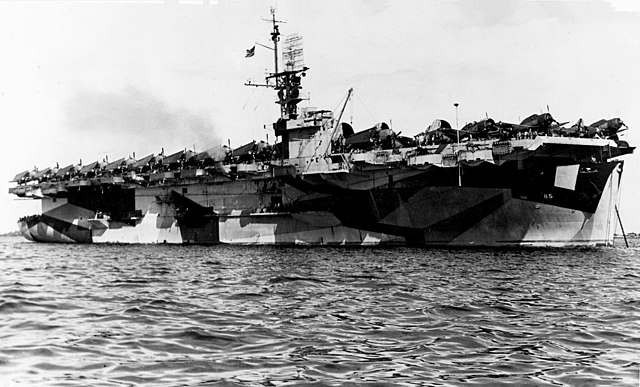
The USS Shipley Bay (CVE-85) was an American escort carrier that served during World War II. She was named after Shipley Bay, a bay on the coast of Alaska.
The Shipley Bay was commissioned in September 1944 and served in the Pacific theater of the war. She was assigned to Task Group 38.3, which was responsible for providing air support for the Allied forces during the Battle of Leyte Gulf.
The ship’s aircraft were used for a variety of missions, including reconnaissance, fighter cover, and ground attack. The Shipley Bay was also used as a transport ship, carrying troops and supplies to various locations in the Pacific.
After the war, the Shipley Bay was used to transport American troops back to the United States. She was decommissioned in 1946 and placed in the reserve fleet. In 1960, she was sold for scrap.
During her service, the Shipley Bay was awarded two battle stars for her participation in the Leyte Gulf landings and the Mindoro landings.
 USS Sitkoh Bay (CVE-86)
USS Sitkoh Bay (CVE-86)
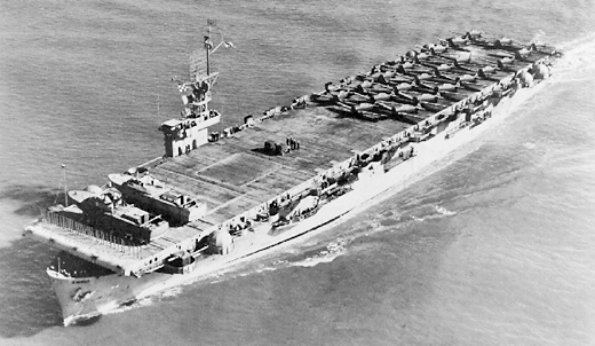
The USS Sitkoh Bay (CVE-86) was an American escort carrier that served during World War II. She was named after Sitkoh Bay, a bay on the coast of Alaska.
The Sitkoh Bay was commissioned in October 1944 and served in the Pacific theater of the war. She was assigned to Task Group 38.3, which was responsible for providing air support for the Allied forces during the Battle of Leyte Gulf.
The ship’s aircraft were used for a variety of missions, including reconnaissance, fighter cover, and ground attack. The Sitkoh Bay was also used as a transport ship, carrying troops and supplies to various locations in the Pacific.
After the war, the Sitkoh Bay was used to transport American troops back to the United States. She was decommissioned in 1946 and placed in the reserve fleet.
 USS Steamer Bay (CVE-87)
USS Steamer Bay (CVE-87)
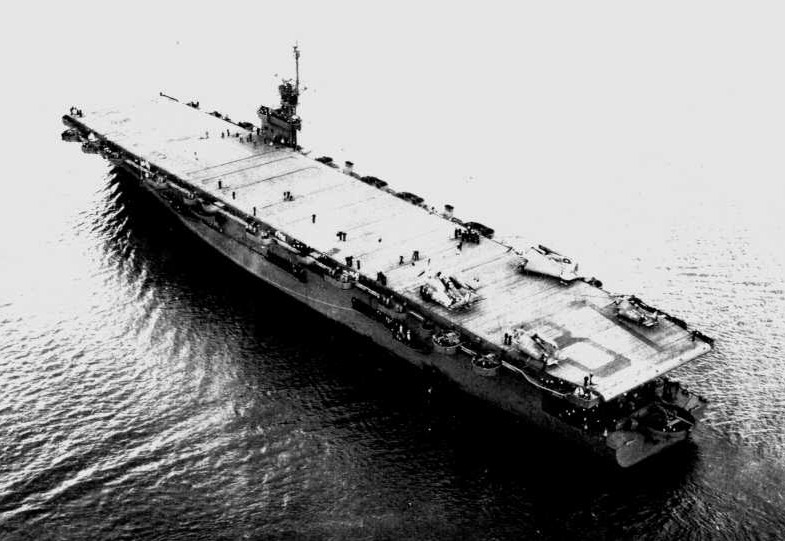
USS Steamer Bay (CVE-87) was an American escort carrier that served during World War II. She was named after Steamer Bay, a bay on the coast of Alaska.
The Steamer Bay was commissioned in November 1944 and served in the Pacific theater of the war. She was assigned to Task Group 38.3, which was responsible for providing air support for the Allied forces during the Battle of Leyte Gulf.
The ship’s aircraft were used for a variety of missions, including reconnaissance, fighter cover, and ground attack. The Steamer Bay was also used as a transport ship, carrying troops and supplies to various locations in the Pacific.
After the war, the Steamer Bay was used to transport American troops back to the United States. She was decommissioned in 1946 and placed in the reserve fleet. In 1960, she was sold for scrap.
During her service, the Steamer Bay was awarded two battle stars for her participation in the Leyte Gulf landings and the Mindoro landings.
 USS Cape Esperance (CVE-88)
USS Cape Esperance (CVE-88)
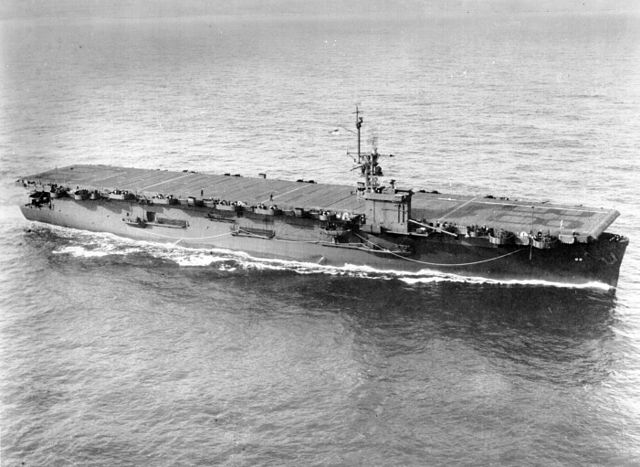
USS Cape Esperance (CVE-88) was named after the Battle of Cape Esperance, which took place during the Guadalcanal Campaign in 1942.
The Cape Esperance was commissioned on February 8, 1944, and completed her shakedown cruise in April of that year. She then joined the Pacific Fleet and participated in the Marianas Campaign, supporting the invasion of Saipan, Guam, and Tinian.
In October 1944, Cape Esperance took part in the Battle of Leyte Gulf, one of the largest naval battles in history. During the battle, she was part of the escort carrier group Taffy 3, which was attacked by a much larger Japanese force. Despite being heavily outnumbered, Taffy 3’s carriers and escorts fought back fiercely, and their actions helped to turn the tide of the battle in favor of the Allies.
After the war, Cape Esperance was decommissioned in June 1946 and placed in reserve. She was later transferred to the Maritime Administration and sold for scrapping in 1971.
 USS Takanis Bay (CVE-89)
USS Takanis Bay (CVE-89)
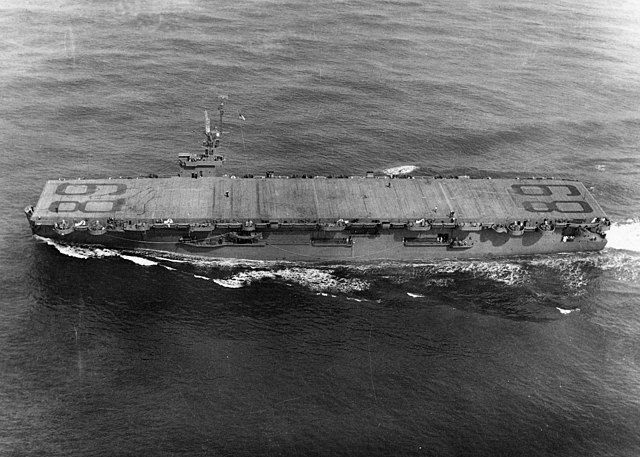
 USS Thetis Bay (CVE-90)
USS Thetis Bay (CVE-90)
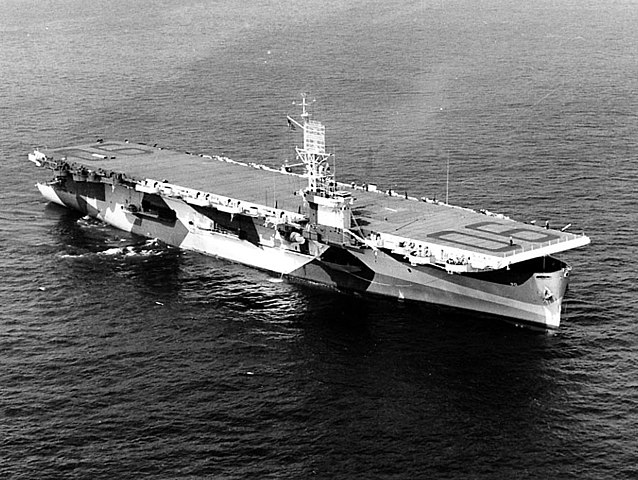
USS Thetis Bay underway on 7 August 1944. The ship is painted in Measure 33, Design 10A camouflage
USS Thetis Bay (CVE-90) was named after Thetis Bay, located in the Aleutian Islands.
Thetis Bay was commissioned on March 15, 1944, and served in the Pacific Theater of Operations during World War II. She participated in several major campaigns, including the Battle of Leyte Gulf, where she provided air support for the invasion of the Philippines.
After the war, Thetis Bay was used to transport troops and equipment back to the United States as part of Operation Magic Carpet. She was decommissioned on April 15, 1946, and placed in reserve.
Thetis Bay was later recommissioned on July 20, 1950, in response to the Korean War. She served as an aircraft transport and helicopter carrier during the conflict, earning three battle stars for her service.
After the war, Thetis Bay continued to serve in various roles, including as a training ship and as a transport for military personnel and equipment. She was finally decommissioned on January 15, 1964, and sold for scrap in 1965.
 USS Makassar Strait (CVE-91)
USS Makassar Strait (CVE-91)
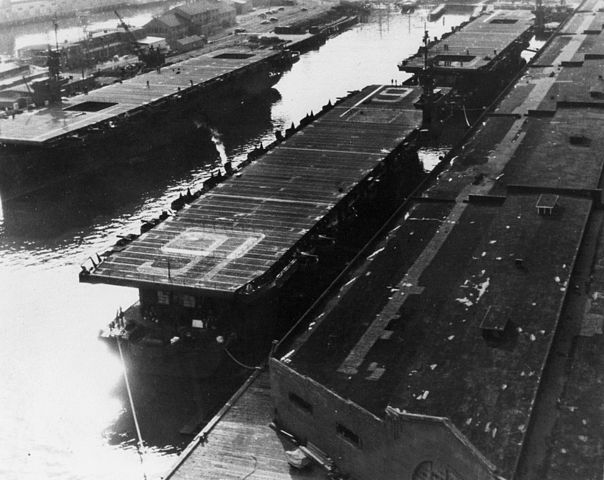
CVE 90 and 91 in dock, 1954
USS Makassar Strait (CVE-91) was named after the Battle of Makassar Strait, a naval battle fought between the Allied and Japanese navies in 1942.
Makassar Strait was commissioned on April 15, 1944, and served in the Pacific Theater of Operations during World War II. She participated in several major campaigns, including the Battle of Leyte Gulf and the Battle of Okinawa, where she provided air support for ground forces.
After the war, Makassar Strait was used to transport troops and equipment back to the United States as part of Operation Magic Carpet. She was decommissioned on June 27, 1946, and placed in reserve.
Makassar Strait was later recommissioned on August 10, 1950, in response to the Korean War. She served as an aircraft transport and helicopter carrier during the conflict, earning two battle stars for her service.
After the war, Makassar Strait continued to serve in various roles, including as a training ship and as a transport for military personnel and equipment. She was finally decommissioned on February 15, 1960, and sold for scrap in 1961.
 USS Wyndham Bay (CVE-92)
USS Wyndham Bay (CVE-92)

USS Windham Bay ferrying F86 jets to Korea in the 1950s
 USS Makin Island (CVE-93)
USS Makin Island (CVE-93)

USS Makin Island underway near Leyte, November 1944
USS Makin Island (CVE-93) was named after the Battle of Makin, a raid by the United States Marine Corps against Japanese forces in the Pacific Theater of Operations during World War II.
Makin Island was commissioned on April 9, 1944, and served in the Pacific Theater of Operations during World War II. She participated in several major campaigns, including the Battle of Leyte Gulf and the Battle of Okinawa, where she provided air support for ground forces.
After the war, Makin Island was used to transport troops and equipment back to the United States as part of Operation Magic Carpet. She was decommissioned on June 27, 1946, and placed in reserve.
Makin Island was later recommissioned on September 1, 1950, in response to the Korean War. She served as an aircraft transport and helicopter carrier during the conflict, earning three battle stars for her service.
After the war, Makin Island continued to serve in various roles, including as a training ship and as a transport for military personnel and equipment. She was finally decommissioned on May 15, 1959, and sold for scrap in 1960.
 USS Lunga Point (CVE-94)
USS Lunga Point (CVE-94)
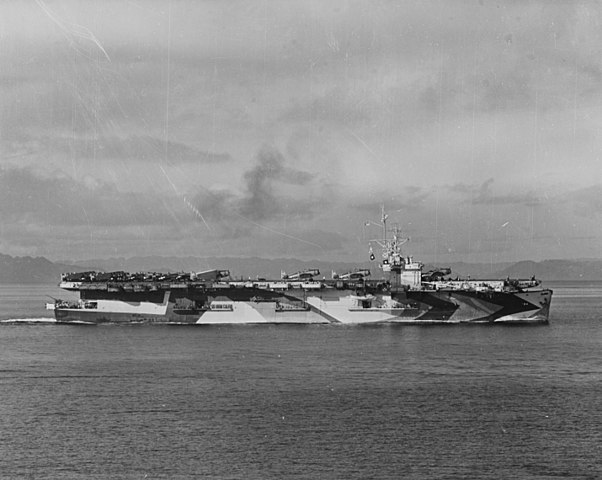
USS Lunga Point (CVE-94) was named after Lunga Point, a promontory on the island of Guadalcanal, which played a key role in the Guadalcanal campaign of 1942-1943.
Lunga Point was laid down on 15 December 1942 at the Kaiser Shipyards in Vancouver, Washington, and launched on 10 May 1943. She was commissioned on 10 November 1943, with Captain H. A. Guthrie in command.
After completing her shakedown cruise off the West Coast, Lunga Point was assigned to the Pacific Fleet and participated in operations against Japanese forces in the South Pacific. She provided air support for the invasion of the Marshall Islands in January 1944 and the invasion of the Mariana Islands in June 1944.
In December 1944, Lunga Point was part of a task group that attacked Japanese shipping in the Sulu Sea. During the attack, she was hit by a kamikaze, which caused significant damage to her flight deck and hangar deck. She was able to return to port for repairs and rejoined the fleet in time for the invasion of Okinawa in April 1945.
After the war, Lunga Point was used to transport American troops back to the United States as part of the “Operation Magic Carpet” program. She was decommissioned in June 1946 and placed in reserve.
Lunga Point was reactivated during the Korean War and served as a transport for military equipment and personnel. She was decommissioned again in 1954 and placed in the Pacific Reserve Fleet. She was struck from the Navy List in 1959 and sold for scrap in 1961.
 USS Bismarck Sea (CVE-95)
USS Bismarck Sea (CVE-95)

USS Bismarck Sea (CVE-95) was named after the Battle of the Bismarck Sea, which took place in March 1943 and resulted in a decisive Allied victory over Japanese naval forces in the South Pacific.
Bismarck Sea was laid down on 15 December 1942 at the Kaiser Shipyards in Vancouver, Washington, and launched on 17 April 1943. She was commissioned on 20 November 1943, with Captain J. W. Harris in command.
After completing her shakedown cruise off the West Coast, Bismarck Sea was assigned to the Pacific Fleet and participated in operations against Japanese forces in the South Pacific. She provided air support for the invasion of the Marshall Islands in January 1944 and the invasion of the Mariana Islands in June 1944.
On 21 February 1945, Bismarck Sea was hit by a kamikaze during the Battle of Iwo Jima. The attack caused a massive explosion that destroyed the ship, killing 318 of her crew and leaving 605 others wounded. The remaining crew members were rescued by nearby ships.
Bismarck Sea received three battle stars for her service during World War II. Her wreck site was discovered by a team of researchers in 2018, located off the coast of the Solomon Islands at a depth of approximately 4,300 meters.
 USS Salamaua (CVE-96)
USS Salamaua (CVE-96)
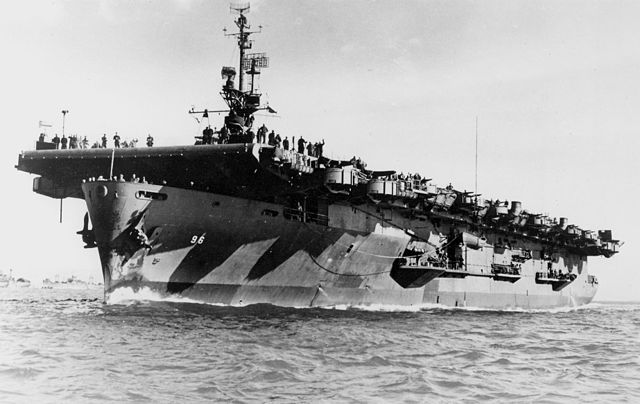
USS Salamaua (CVE-96) was named after the Battle of Salamaua, which took place during the New Guinea campaign of World War II.
Salamaua was laid down on 7 June 1944 at the Todd-Pacific Shipyards in Tacoma, Washington, and launched on 21 July 1944. She was commissioned on 15 January 1945, with Captain W. W. Kilpatrick in command.
After completing her shakedown cruise off the West Coast, Salamaua was assigned to the Pacific Fleet and participated in the final stages of the war against Japan. She operated in Japanese waters and provided air support for the occupation of Japan until November 1945.
After the war, Salamaua was assigned to the “Magic Carpet” operation, which involved the transportation of American troops from overseas back to the United States. She made several “Magic Carpet” voyages before being placed in reserve in 1946.
Salamaua was reactivated in 1951 and assigned to the Atlantic Fleet. She operated in the Mediterranean and the Caribbean, providing air support for fleet operations and participating in NATO exercises. In 1959, she was decommissioned and placed in reserve.
Salamaua was struck from the Navy List on 1 September 1959 and transferred to the Maritime Administration for disposal. She was sold for scrap to the Nicolai Joffe Corporation of Beverly Hills, California, in August 1960.
 USS Hollandia (CVE-97)
USS Hollandia (CVE-97)
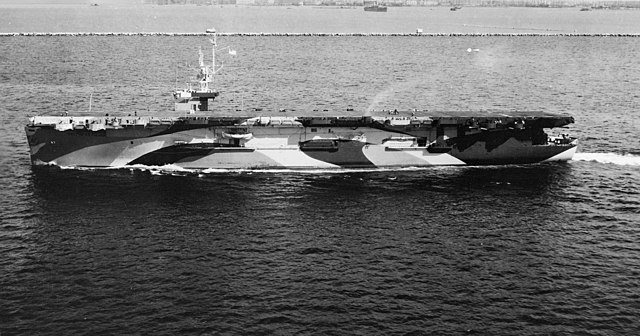
USS Hollandia (CVE-97) was named after the Battle of Hollandia, which took place during the New Guinea campaign of World War II.
Hollandia was laid down on 22 May 1944 at the Todd-Pacific Shipyards in Tacoma, Washington, and launched on 28 June 1944. She was commissioned on 6 December 1944, with Captain J. M. Shoemaker in command.
After completing her shakedown cruise off the West Coast, Hollandia was assigned to the Pacific Fleet and participated in the final stages of the war against Japan. She operated in Japanese waters and provided air support for the occupation of Japan until November 1945.
After the war, Hollandia was assigned to the “Magic Carpet” operation, which involved the transportation of American troops from overseas back to the United States. She made several “Magic Carpet” voyages before being placed in reserve in 1946.
Hollandia was reactivated in 1951 and assigned to the Atlantic Fleet. She operated in the Mediterranean and the Caribbean, providing air support for fleet operations and participating in NATO exercises. In 1959, she was decommissioned and placed in reserve.
Hollandia was struck from the Navy List on 1 September 1959 and transferred to the Maritime Administration for disposal. She was sold for scrap to the Nicolai Joffe Corporation of Beverly Hills, California, in August 1960.
 USS Kwajalein (CVE-98)
USS Kwajalein (CVE-98)
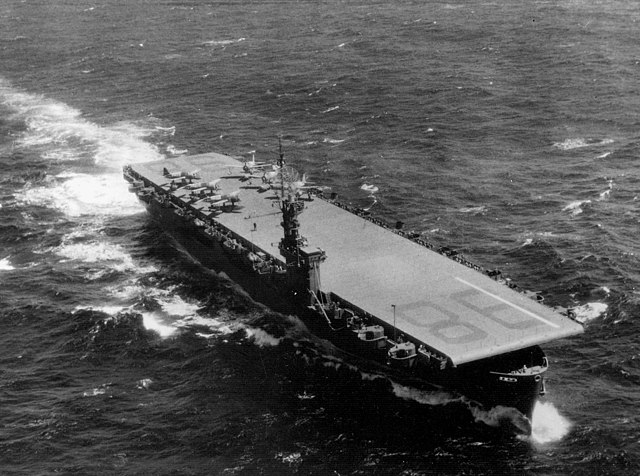
USS Kwajalein 28 June 1944
USS Kwajalein (CVE-98) was named after the Battle of Kwajalein, which took place during the Pacific campaign of World War II. Kwajalein was laid down on 23 May 1944 at the Todd-Pacific Shipyards in Tacoma, Washington, and launched on 11 July 1944. She was commissioned on 18 November 1944, with Captain J. H. Carson in command.
After completing her shakedown cruise off the West Coast, Kwajalein was assigned to the Pacific Fleet and participated in the final stages of the war against Japan. She operated in Japanese waters and provided air support for the occupation of Japan until November 1945.
After the war, Kwajalein was assigned to the “Magic Carpet” operation, which involved the transportation of American troops from overseas back to the United States. She made several “Magic Carpet” voyages before being placed in reserve in 1946.
Kwajalein was reactivated in 1951 and assigned to the Atlantic Fleet. She operated in the Mediterranean and the Caribbean, providing air support for fleet operations and participating in NATO exercises. In 1958, she was decommissioned and placed in reserve.
Kwajalein was struck from the Navy List on 1 March 1959 and transferred to the Maritime Administration for disposal. She was sold for scrap to the Nicolai Joffe Corporation of Beverly Hills, California, in July 1960.
 USS Admiralty Islands (CVE-99)
USS Admiralty Islands (CVE-99)

USS Admiralty Islands ferrying planes 31 Dec. 1944
USS Admiralty Islands (CVE-99) was named after the Admiralty Islands in the southwestern Pacific. Admiralty Islands was laid down on 15 June 1944 at the Todd-Pacific Shipyards in Tacoma, Washington, and launched on 30 August 1944. She was commissioned on 9 January 1945, with Captain M. C. Hines in command.
After completing her shakedown cruise off the West Coast, Admiralty Islands was assigned to the Pacific Fleet and participated in the final stages of the war against Japan. She operated in Japanese waters and provided air support for the occupation of Japan until November 1945.
After the war, Admiralty Islands was assigned to the “Magic Carpet” operation, which involved the transportation of American troops from overseas back to the United States. She made several “Magic Carpet” voyages before being placed in reserve in 1946.
Admiralty Islands was reactivated in 1951 and assigned to the Atlantic Fleet. She operated in the Mediterranean and the Caribbean, providing air support for fleet operations and participating in NATO exercises. In 1958, she was decommissioned and placed in reserve.
Admiralty Islands was struck from the Navy List on 1 March 1959 and transferred to the Maritime Administration for disposal. She was sold for scrap to the Nicolai Joffe Corporation of Beverly Hills, California, in July 1960.
 USS Bougainville (CVE-100)
USS Bougainville (CVE-100)
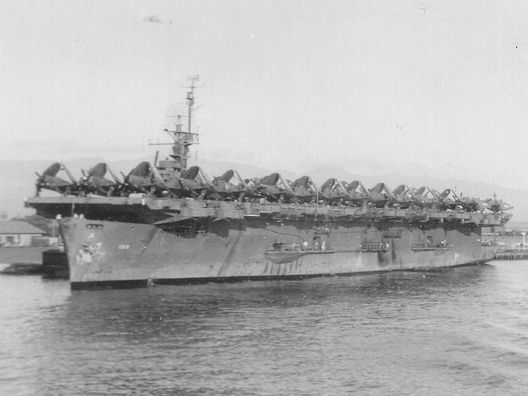
USS Bougainville (CVE-100) was named after the Battle of Bougainville, which took place during the Guadalcanal Campaign in 1943.
Bougainville was laid down on 15 August 1944 at the Todd-Pacific Shipyards in Tacoma, Washington, and launched on 21 October 1944. She was commissioned on 9 February 1945, with Captain J. M. Shoemaker in command.
After completing her shakedown cruise off the West Coast, Bougainville was assigned to the Pacific Fleet and participated in the final stages of the war against Japan. She operated in Japanese waters and provided air support for the occupation of Japan until November 1945.
After the war, Bougainville was assigned to the “Magic Carpet” operation, which involved the transportation of American troops from overseas back to the United States. She made several “Magic Carpet” voyages before being decommissioned on 30 June 1946.
Bougainville was transferred to the Maritime Administration for disposal on 1 July 1960 and sold for scrap to the Nicolai Joffe Corporation of Beverly Hills, California, in October 1960.
 USS Matanikau (CVE-101)
USS Matanikau (CVE-101)

USS Matanikau (CVE-101) was named after the Battle of the Matanikau, which took place during the Guadalcanal Campaign in 1942. Matanikau was laid down on 6 October 1944 at the Todd-Pacific Shipyards in Tacoma, Washington, and launched on 7 December 1944. She was commissioned on 27 March 1945, with Captain S. S. Lewis in command.
After completing her shakedown cruise off the West Coast, Matanikau was assigned to the Pacific Fleet and participated in the final stages of the war against Japan. She operated in Japanese waters and provided air support for the occupation of Japan until November 1945.
After the war, Matanikau was assigned to the “Magic Carpet” operation, which involved the transportation of American troops from overseas back to the United States. She made several “Magic Carpet” voyages before being decommissioned on 30 June 1946.
Matanikau was transferred to the Maritime Administration for disposal on 1 July 1960 and sold for scrap to the Nicolai Joffe Corporation of Beverly Hills, California, in October 1960.
 USS Attu (CVE-102)
USS Attu (CVE-102)

USS Attu (CVE-102) was named after the Battle of Attu, which took place in the Aleutian Islands in May 1943. She was laid down on 21 November 1944 at the Todd-Pacific Shipyards in Tacoma, Washington, and launched on 25 January 1945. She was commissioned on 30 April 1945, with Captain A. C. Sherman in command. After completing her shakedown cruise off the West Coast, Attu was assigned to the Pacific Fleet and participated in the final stages of the war against Japan. She operated in Japanese waters and provided air support for the occupation of Japan until November 1945.
After the war, Attu was assigned to the “Magic Carpet” operation, which involved the transportation of American troops from overseas back to the United States. She made two “Magic Carpet” voyages before being decommissioned on 12 June 1946.
Attu was transferred to the Maritime Administration for disposal on 1 July 1960 and sold for scrap to the Nicolai Joffe Corporation of Beverly Hills, California, in October 1960.
 USS Roi (CVE-103)
USS Roi (CVE-103)
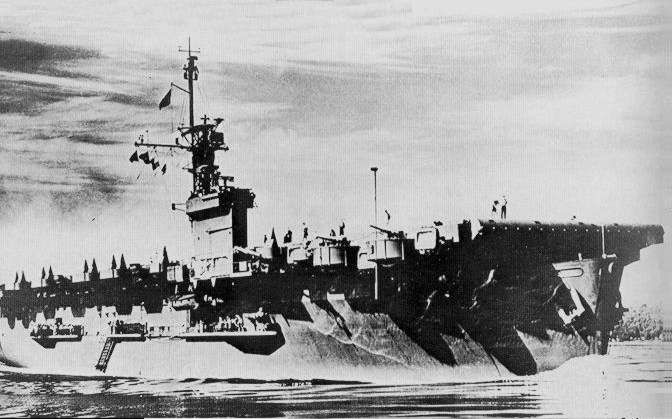
USS Roi was named after the Roi Atoll, one of the islands in the Kwajalein Atoll in the Marshall Islands.
She was laid down on 17 December 1944 at the Todd-Pacific Shipyards in Tacoma, Washington, and launched on 28 February 1945. She was commissioned on 25 June 1945, with Captain A. J. Malone in command.
After completing her shakedown cruise, Roi was assigned to the Pacific Fleet and participated in the occupation of Japan. She operated in Japanese waters until January 1946, when she was ordered to return to the United States.
Roi was decommissioned on 12 June 1946 and placed in reserve. She was struck from the Navy List on 1 March 1959 and sold for scrap in 1960.
 USS Munda (CVE-104)
USS Munda (CVE-104)

USS Munda (CVE-55) was a Casablanca-class escort carrier of the United States Navy during World War II. She was named after the Battle of Munda in the Solomon Islands, which took place in 1943.
The ship was laid down on 22 February 1943 at the Kaiser Shipyards in Vancouver, Washington, and launched on 28 April 1943. She was commissioned on 27 August 1943, with Captain E. J. McCarthy in command.
After completing her shakedown cruise off the California coast, Munda departed San Diego on 27 October 1943, bound for the South Pacific. She arrived at Nouméa, New Caledonia, on 17 November and began operating with Task Group 37.4, providing air cover for the invasion of the Gilbert Islands. She continued to provide air support for various operations in the Pacific theater throughout the war.
In addition to her service in the Pacific, Munda also participated in the invasion of southern France in August 1944, providing air cover for the amphibious landings.
After the war, Munda was decommissioned on 16 February 1946 and transferred to the Maritime Commission for disposal. She was struck from the Navy List on 12 March 1946 and sold for scrap to the Hugo Neu Corporation of New York City on 21 November 1946.








 Latest Facebook Entry -
Latest Facebook Entry -  X(Tweeter) Naval Encyclopedia's deck archive
X(Tweeter) Naval Encyclopedia's deck archive Instagram (@navalencyc)
Instagram (@navalencyc)





 French Navy
French Navy Royal Navy
Royal Navy Russian Navy
Russian Navy Armada Espanola
Armada Espanola Austrian Navy
Austrian Navy K.u.K. Kriegsmarine
K.u.K. Kriegsmarine Dansk Marine
Dansk Marine Nautiko Hellenon
Nautiko Hellenon Koninklije Marine 1870
Koninklije Marine 1870 Marinha do Brasil
Marinha do Brasil Osmanlı Donanması
Osmanlı Donanması Marina Do Peru
Marina Do Peru Marinha do Portugal
Marinha do Portugal Regia Marina 1870
Regia Marina 1870 Nihhon Kaigun 1870
Nihhon Kaigun 1870 Preußische Marine 1870
Preußische Marine 1870 Russkiy Flot 1870
Russkiy Flot 1870 Svenska marinen
Svenska marinen Søværnet
Søværnet Union Navy
Union Navy Confederate Navy
Confederate Navy Armada de Argentina
Armada de Argentina Imperial Chinese Navy
Imperial Chinese Navy Marinha do Portugal
Marinha do Portugal Mexico
Mexico Kaiserliche Marine
Kaiserliche Marine 1898 US Navy
1898 US Navy Sovietskiy Flot
Sovietskiy Flot Royal Canadian Navy
Royal Canadian Navy Royal Australian Navy
Royal Australian Navy RNZN Fleet
RNZN Fleet Chinese Navy 1937
Chinese Navy 1937 Kriegsmarine
Kriegsmarine Chilean Navy
Chilean Navy Danish Navy
Danish Navy Finnish Navy
Finnish Navy Hellenic Navy
Hellenic Navy Polish Navy
Polish Navy Romanian Navy
Romanian Navy Turkish Navy
Turkish Navy Royal Yugoslav Navy
Royal Yugoslav Navy Royal Thai Navy
Royal Thai Navy Minor Navies
Minor Navies Albania
Albania Austria
Austria Belgium
Belgium Columbia
Columbia Costa Rica
Costa Rica Cuba
Cuba Czechoslovakia
Czechoslovakia Dominican Republic
Dominican Republic Haiti
Haiti Hungary
Hungary Honduras
Honduras Estonia
Estonia Iceland
Iceland Eire
Eire Equador
Equador Iran
Iran Iraq
Iraq Latvia
Latvia Liberia
Liberia Lithuania
Lithuania Mandchukuo
Mandchukuo Morocco
Morocco Nicaragua
Nicaragua Persia
Persia San Salvador
San Salvador Sarawak
Sarawak Uruguay
Uruguay Venezuela
Venezuela Zanzibar
Zanzibar Warsaw Pact Navies
Warsaw Pact Navies Bulgaria
Bulgaria Hungary
Hungary

 Bundesmarine
Bundesmarine Dutch Navy
Dutch Navy Hellenic Navy
Hellenic Navy Marina Militare
Marina Militare Yugoslav Navy
Yugoslav Navy Chinese Navy
Chinese Navy Indian Navy
Indian Navy Indonesian Navy
Indonesian Navy JMSDF
JMSDF North Korean Navy
North Korean Navy Pakistani Navy
Pakistani Navy Philippines Navy
Philippines Navy ROKN
ROKN Rep. of Singapore Navy
Rep. of Singapore Navy Taiwanese Navy
Taiwanese Navy IDF Navy
IDF Navy Saudi Navy
Saudi Navy Royal New Zealand Navy
Royal New Zealand Navy Egyptian Navy
Egyptian Navy South African Navy
South African Navy






























 Ukrainian Navy
Ukrainian Navy dbodesign
dbodesign
USS Wake Island (CVE-65)
…where she served as Dixmude ???
USS White Plains (CVE-66)
…where she served as Dixmude ???
Thx, fixed, at the time these were chatgpt requests to gain time. I plan an update in 2026.